


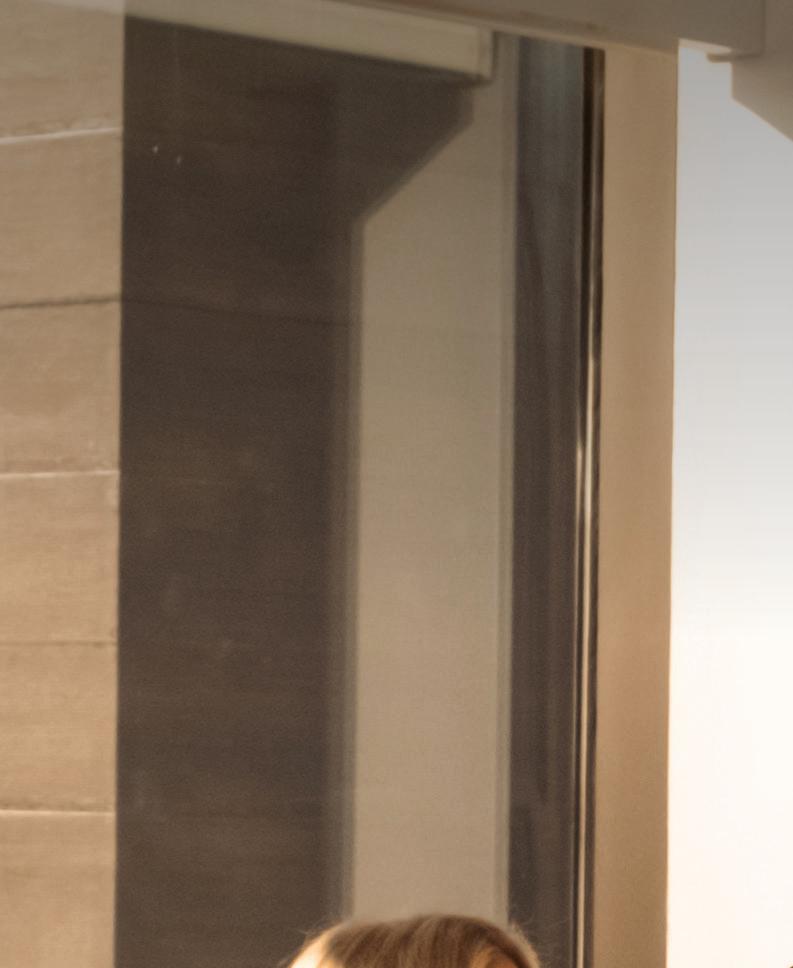








STUART SAFT





















For decades, we have built a real estate practice unparalleled in the US. Now, as the global legal powerhouse HSF Kramer, we are so much more. As the only law firm ranked in Chambers Band 1 in the US, the UK and Australia, we continue to transform skylines and reshape landscapes. Please visit our website to learn more. Kramer Levin is now HSF Kramer




























Holland & Knight’s New York Real Estate Practice Group and Real Estate Capital Markets Practice Group successfully closed deals worth more than $11.35 billion in 2024. From acquisitions, dispositions, development, condominium and cooperative formation and operation to hospitality, financing, leasing, land use and real estate capital markets, our attorneys do their utmost to deliver clients with exceptional results across all sectors.
Acquisitions and Dispositions: $1.93 billion
Financing: $4.1 billion
Leasing: $3.2 billion
Land Use: $290 million



Defaulted Loans, Workouts and Liquidations: $1.83 billion
www.hklaw.com
Stuart M. Saft, Partner | Real Estate Practice Group

Keith M. Brandofino, Partner | Real Estate Capital Markets Practice Group New York, NY | +1.212.513.3200

















































































EDITORIAL
Editor
Debra Hazel
Director of Communications and Marketing
Penelope Herrera
Director of
Newsletter Division
Cheri Phillips
PRESIDENT/CEO
Jeff Mann
ART
Art Director
Virginia Sanchez
Cover Photography
Isaiah Gill
Marshal Cohen
Frank DeLucia
Peter Dixon
Matt Ellis
Craig Gillespie
Kris Kiser
Bob Knakal
Ira Meister
Jose Reyes
Carol A. Sigmond
Amanda Stanaway
Bentley Zhao
Technology Consultant Eric Loh
Distribution Mitchell’s Delivery Service
DIGITAL MEDIA
Designers
Virginia Sanchez
Editors
Debra Hazel
Penelope Herrera
Rose Leveen
Cheri Phillips
Web Developer
CS Designworks
West Coast Office: 578 Washington Blvd., Suite 827
Marina Del Rey, CA 90292 866-306-MANN (6266) mannpublications.com




East Coast Office: 450 7th Ave, Suite 2306
New York, NY 10123 212-840-MANN (6266)



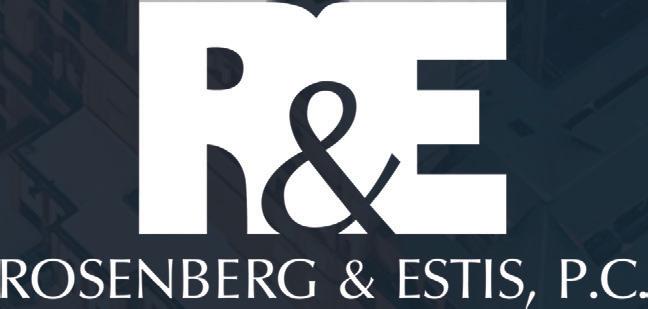
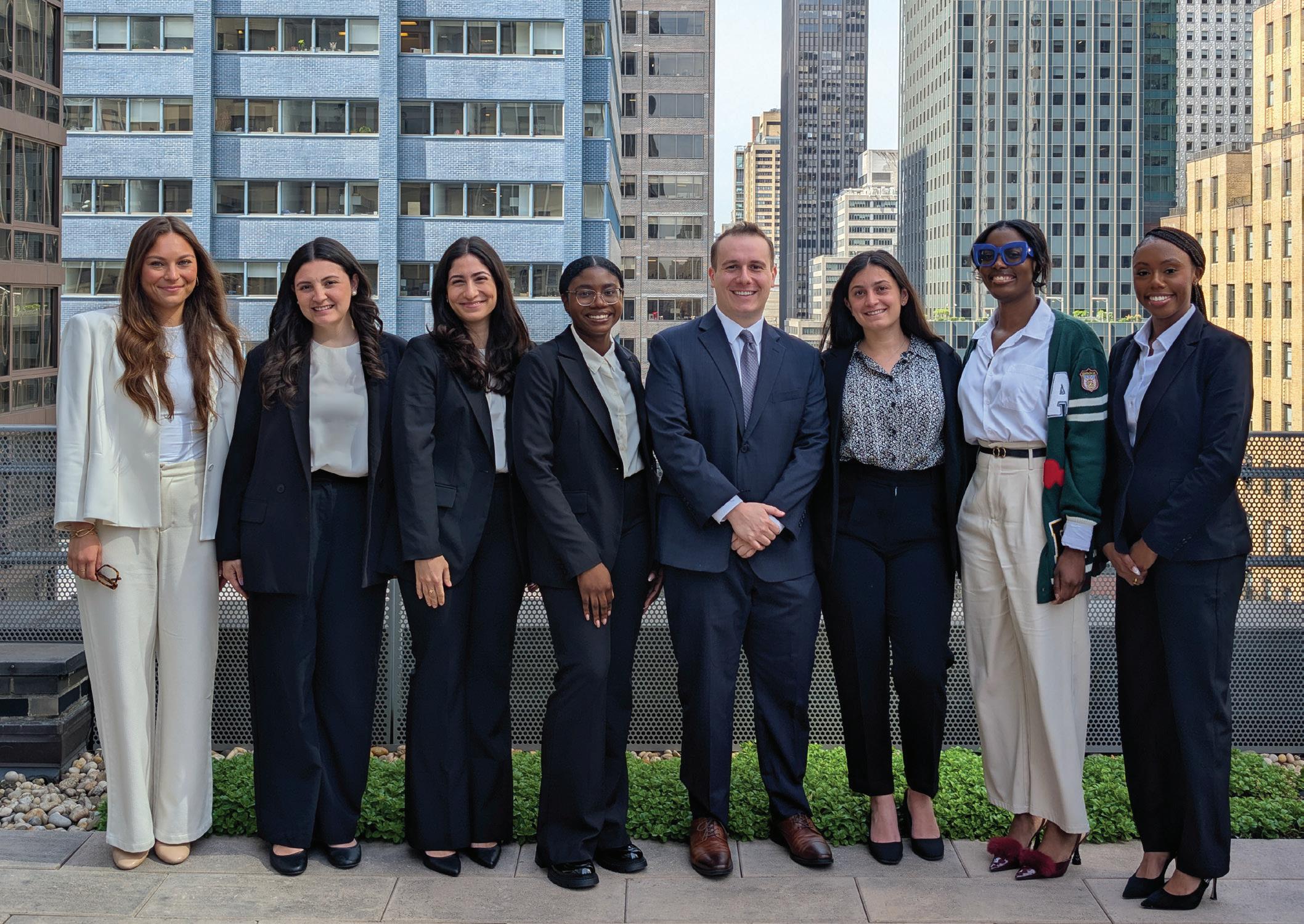



In this letter, I want to pay tribute to some of the good guys of our industry. Stuart Saft is such a mensch that it can be hard to remember that he’s one of the most influential real estate lawyers in New York City. His practice at Holland & Knight is proof of both, doing billions in billings, while also providing a haven for his associates. In what can be a cut-throat business, Stuart has established a collaborative atmosphere that is family-friendly, and one where attorneys stay.
Our cover feature is like sitting at lunch with an old friend. Enjoy.
I hope you will join us at the Fresh Meadow Country Club and enjoy a day of golf, fine dining and networking at the annual golf outing that this year will benefit two foundations close to my heart — The Mann Charitable Foundation and the National Realty Club Foundation — on October 6. Monies raised will support causes including Alzheimer’s Disease, Crohn’s and Colitis, Lymphoma and Macular Degeneration, as well as organizations such as the Bronx Historical Society, Community Mainstream, National Jewish Museum, Jewish National Fund, Catholic Faith Network and Nassau County Law Enforcement Exploring, among others. Our honorees are Martin Efron, managing director at White Oak Commercial Finance, and Jaimee L. Nardiello, partner at Zetlin & De Chiara LLP.
For more information about tickets and sponsorships, please contact Penelope Herrera at pherrera@themanncharitablefoundation.com or penny@ nationalrealtyclub.org.
And to conclude, I want to pay tribute to another good guy — my childhood and lifelong friend Michael Kerr of M&R Management, who left us last month, way too soon. Annie, our industry and I will miss him. His memory already is a blessing.

“Nice guys finish first. If you don't know that, then you don't know where the finish line is.” — Garry Shandling






















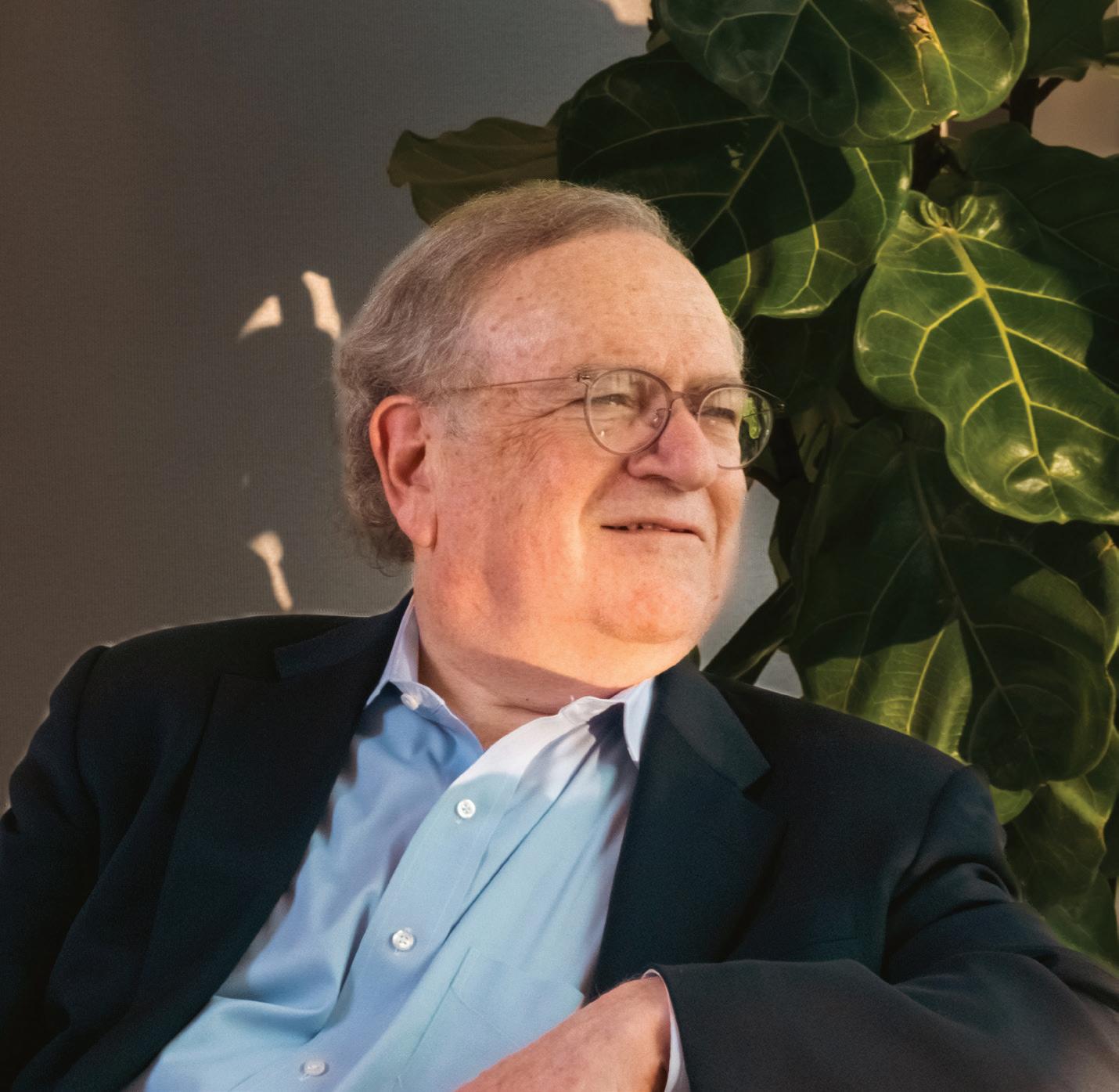




8:30 AM Arrival and Registration
9:00 AM Breakfast/Brunch
11:00 AM Call to Carts

11:15 AM (Sharp) Shotgun Start
5:00 - 6:00 PM Hors d’Oeuvres and Cocktails
6:00 - 7:00 PM
Dinner and Presentation of Golf Winners and Honorees








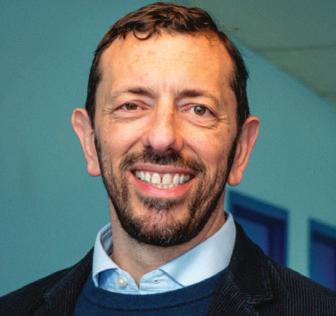

Join Jeff Mann, The Mann Charitable Foundation and the National Realty Club Foundation as we are having a joint golf outing this year. On October 6, 2025, be prepared for another stellar annual golf outing. This outing will support causes such as Alzheimer’s disease, Crohn’s and Colitis, Lymphoma, Macular Degeneration along with raising money for the areas of NYC that need support including Bronx Historical Society, Community Mainstream, National Jewish Museum, Jewish National Fund, Catholic Faith Network, Nassau County Law Enforcement Exploring, among other areas.

With over 75 years of experience and deep understanding of industry challenges, IDB’s Commercial Real Estate team supports property owners, developers and builders across every type of financing requirement. We can help you keep pace with changes in the marketplace, while maintaining high credit quality levels and providing the personalized service, efficiency and flexibility to fit your specific needs. For more information about financing solutions that meet your specific needs, visit idbny.com.





At Peninsula Property Management (PPM), we do more than manage properties—we elevate them. With a leadership team that is deeply involved, hands-on, and responsive, PPM is redefining the standard for property management in New York City. Our mission is simple: deliver results with integrity, precision, and a hospitality-first approach.

Proactive Management
Stop issues before they start — from Local Law 97 to vendor oversight.
Financial Clarity
Clean, timely financials. No surprises –just strategic planning and transparency.
NYC Compliance Expertise
DOB, HPD, LL88, LL97, FISP we navigate every regulation so you don’t have to.
New Development Services
Schedule B, TCO phasing, hiring of staff, punch-list, insurance implementation.
Smart Cost Control
Energy savings, bulk contracts, vendor negotiations we cut waste, not corners.
Real-Time Technology
Track requests, tasks, and reports live through our integrated digital platform.
Welcome back and welcome to our Evolution Issue. What’s so interesting, and even fun, about real estate is that it is constantly changing. This month, we learn about these shifts from some true experts.
As cloud usage grows, one of the most-needed development categories is data centers. AO’s Jose Reyes gives us a primer on how to design and build one of these often-massive projects cost-effectively. ERA-co’s Amanda Stanaway offers a view on how “workplace character” will encourage employees back to the office and to peak productivity. Craig Gillespie, CEO of Airtower Networks, describes how connectivity will be the greatest amenity in the workplace, and could become a critical part of leasing negotiations. Meanwhile, Bentley Zhao of New Empire Corp. updates us on Queens and we learn a bit more about Los Angeles-based Cityview’s plan to expand on the East Coast.
As always, our columnists provide great insight into such diverse topics as the Energy Star program, the taxation of multifamily and the implications of a possible Mamdani term as mayor. It’s a pleasure to highlight them all.
Enjoy the rest of the summer!




Herbert Smith Freehills
Kramer hosted its annual Real Estate and Land Use Cocktail
Reception at the iconic Bryant Park Grill, welcoming a full house of industry professionals to mark the start of summer — and a new chapter for the


firm. This year’s event was the first held under the new HSF Kramer name, following the recent combination of Herbert Smith Freehills and Kramer Levin. The evening drew a who’s who of New York’s real estate scene.




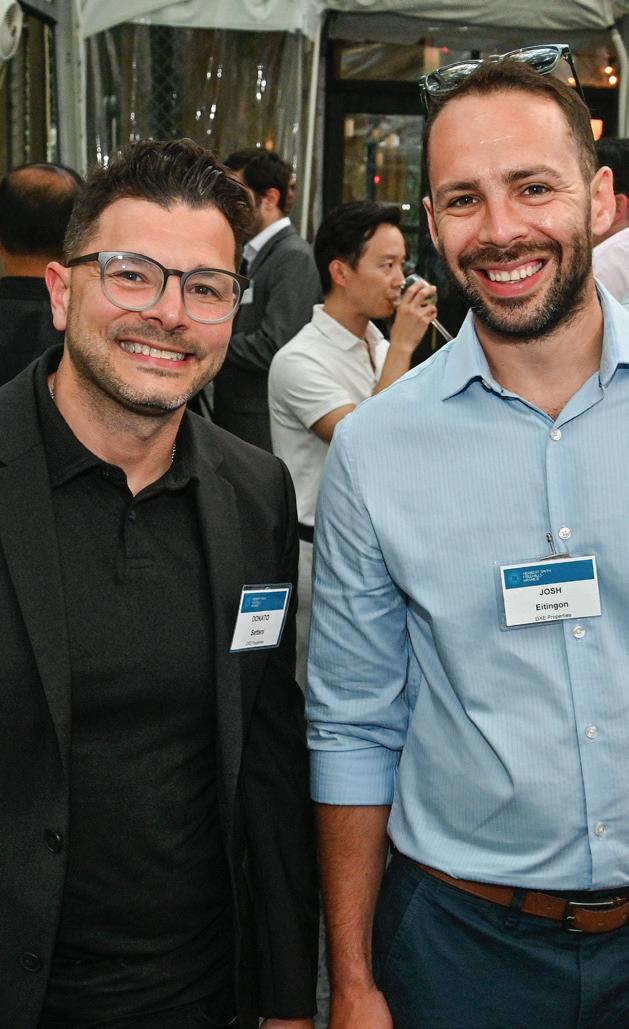



















Real estate professionals from across New York recently gathered in Midtown East, Manhattan, for Jewish National Fund-USA’s annual Leonard Litwin New York City Real Estate Tree of Life Gala, which honored two industry professionals for their outstanding leadership, generosity and philanthropic support of the land and people of Israel.
Co-chaired by Glen Weiss of Vornado Realty Trust and last year’s honoree Neil J. Goldmacher of Newmark, the annual celebration honored Simon J. Elkharrat, partner at Fried, Frank, Shriver & Jacobson LLP as the 2025 Tree of Life Award recipient, and Jay Miller, founder and managing Partner of BayBridge Real Estate Capital, with the Gregory A. Davis Leadership Award, which recognizes exceptional young philanthropists between the ages of 22 and 40.
Elkharrat represents leading players in commercial real estate. His fi rm is known for its prestigious clientele and strong commitment to philanthropy, including its long-standing support of Jewish National Fund-USA. In 2021, The Legal Aid Society of New York honored him with its annual Pro Bono Publico Award for outstanding service to Legal Aid and its clients.
“I think we can all agree that what makes our industry so fun is the tangible nature of real estate — you can see and feel the deals we





work on,” said Elkharrat. “That is why our industry has always been a huge supporter of Jewish National Fund-USA. The organization reminds us that supporting the people of Israel starts with the land. That our connection to Israel isn’t just symbolic, it’s tangible.”
Miller has received numerous accolades, including Dealmaker of the Year from the 2024 South Florida Structures Awards. He also brings a wealth of expertise to Jewish National Fund-USA as co-chair of the organization’s New York Real Estate Cabinet and member of the New York Regional Board of Directors.
“One of the reasons that I am such a proud Zionist is that I believe that not only is Israel our holy land, but I believe that as Jews we need to protect our existence,” said Miller. “By having modernday Israel, we have a seat at the table on the world stage, the world does business with us, we have political allies, and a military to defend ourselves. I believe that one of the reasons we live free, in places like America, is because we have the counterbalance of Israel in the world. I believe that all Jews have to do their part to support Israel and us in the diaspora, which means giving money, time and resources.”
This year’s celebration not only honored industry excellence but reinforced the values that unite Jewish National Fund-USA and the real estate community.














The International Facility Management Association (IFMA) Greater NYC Chapter Awards for Excellence, honoring individuals and corporations who have demonstrated exceptional achievements within the industry, took place at The Pierre. The association recognized excellence across a variety of categories, celebrating the hard work, innovation and leadership that continue to elevate facility management.













From left: Raymond Pezzuti, Fried Frank; Danijel Pocanic, Nelson Worldwide; Michael Schwartzberg, Steinway Moving and Storage; Tim Burdge, Syska Hennessy Group; Jessica Bogdan, Haworth; Rick Malan, Telecom Infrastructure Corp.; Janine Brennan, AllSeating; Alexandra Liz, Blackstone; Peter Lorenz; Helena Loman, Formcraft; Jennifer Kramer, Millerknoll; Yale Stogel, Alan Margolin & Associates and Carmen Sanchez Miller, GenMab










The Breath of Life New York Golf Tournament brought together friends and business leaders for networking and friendly competition to benefit National Jewish Health, the leading respiratory hospital in the nation.
More than 80 golfers shrugged off the day’s drizzle to play the course at Old Oaks Country Club in Purchase, N.Y.
The event, which raised $173,000, was chaired by Roger Silverstein, executive vice president of Silverstein Properties Inc. and a member of the National Jewish Health Council of Trustees.
“The generosity of our sponsors and players truly makes a
difference in the lives of millions of children and adults around the world who benefit both directly and indirectly from the research and care of National Jewish Health,” he said. The Denver-based medical center is a global health leader specializing in lung, heart, immune and related conditions.
Chairs emeriti of the event were Robert Helpern of Tannenbaum Helpern Syracuse & Hirschtritt LLP; Samuel Lewis and Stephen Siegel of CBRE Inc., who are also members of the Council of National Trustees. Top-level sponsors included 1251 Avenues of the Americas; CBRE; Greenberg Traurig; founders of the Fund to Cure Asthma golf tournament Marjorie and Stephen Raphael, a trustee and Wilk Auslander.













"The generosity of our sponsors and players truly makes a difference in the lives of millions of children and adults around the world who bene t both directly and indirectly from the research and care of National Jewish Health"
Roger Silverstein

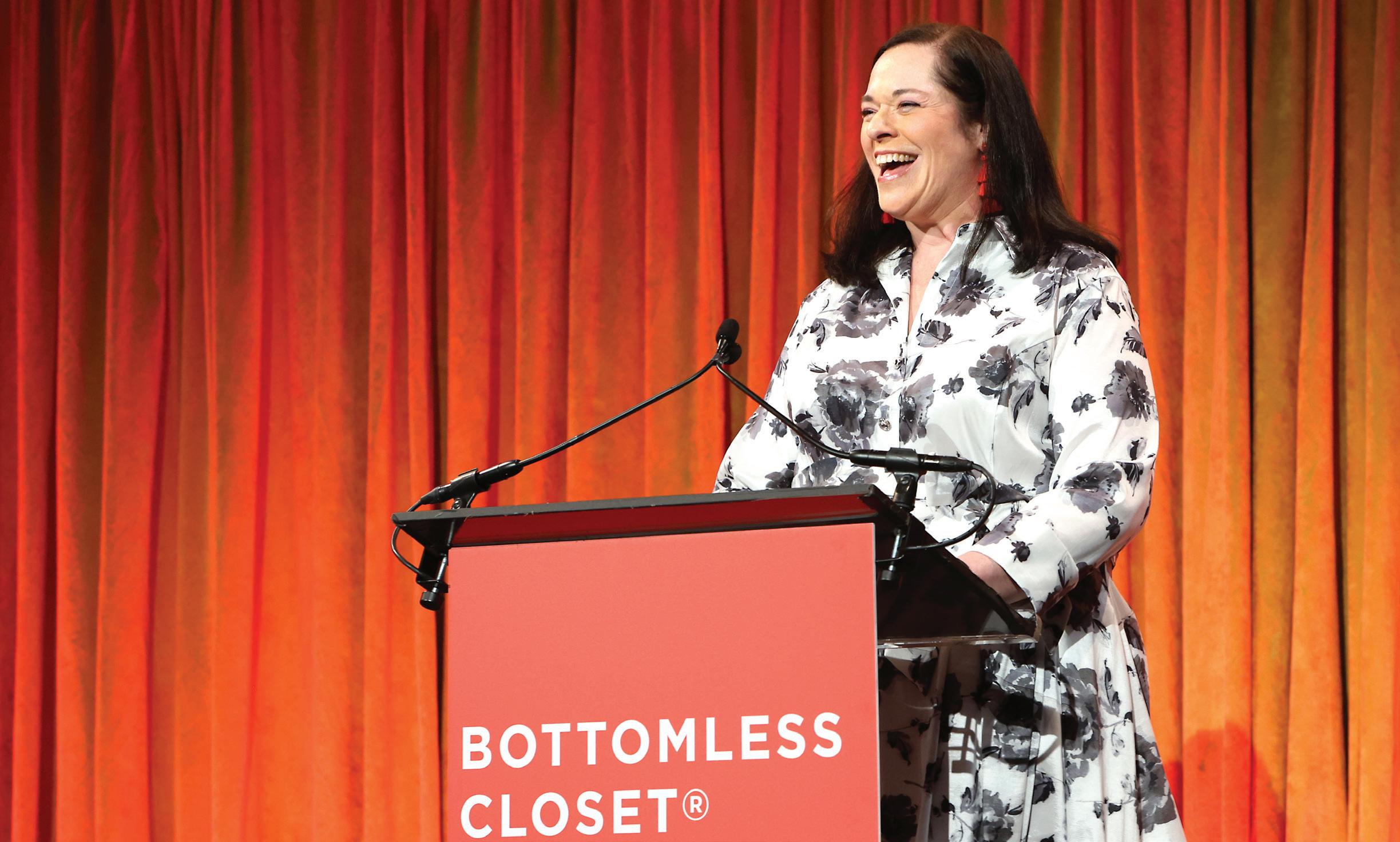
Bottomless Closet hosted its Annual Spring Luncheon at Cipriani 42nd Street, bringing together more than 400 guests to celebrate women’s empowerment and honor individuals advancing equity in the workplace. Emceed by PIX11’s Monica Morales, the event highlighted this year’s theme, “From Obstacles to Opportunities,” through powerful stories of transformation and impact.
Honorees included tennis icon and entrepreneur Venus Williams (Game Changer Award), Manuel Chinea of Popular Bank (Male Ally Award), Stacey Dackson of Structure Tone (Inspiration Award), longtime board member Anne Blackman (Distinguished Leadership Award) and volunteer Stefanie Steel (Luise Kleinberg Volunteer Award).
A panel of clients reflected on how the organization helped them build confidence, find purpose and set meaningful goals. Client Dianette Caraballo shared her emotional journey from homelessness to employment, calling Bottomless Closet a turning point in her life.
Founded in 1999, Bottomless Closet provides free career coaching, resume preparation, interview training, and professional attire to help women in need secure employment and achieve financial independence. Executive Director Melissa Norden announced plans to expand services by 32% in 2025. Proceeds from the luncheon will support these critical programs.




National Jewish Health Hosts 32nd Annual


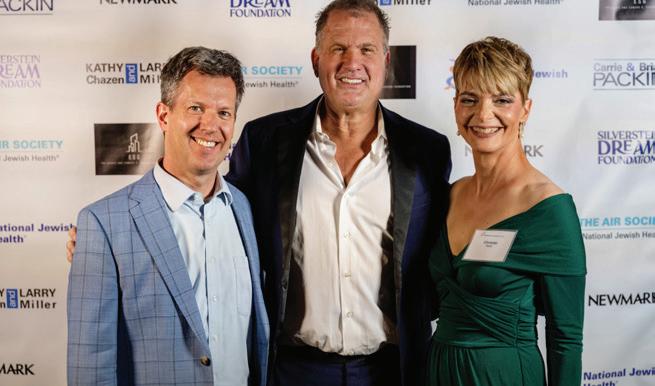



Nearly 200 guests gathered for The Sky’s the Limit New York Air Society Gala to honor Slater B. Traaen, senior director of Mitsui Fudosan America. Since 1991, the New York AIR Society has supported research and care of asthma, immunology and respiratory (AIR) medicine at National Jewish Health.
The event, held at Ascent Lounge New York, raised more than $230,000 and was chaired by Jennifer Widay, vice president of Kaback Service Inc.
“Slater Traaen is a truly incredible individual who leads by example in his service to business, community and philanthropy,” said Widay.
Traaen was honored with the Irving Borenstein Memorial
Award in recognition of his passion for giving back and fostering meaningful impact in the community. The award was presented by chair emeritus of the event, Roger Silverstein, executive vice president of Silverstein Properties, who is a national trustee of the National Jewish Health Council.
Dr. David Beuther, pulmonologist and chief medical information officer for National Jewish Health, gave a hospital update. Additional leadership included Kathy Chazen, chair emerita of this event and a trustee of the hospital. Top-level sponsors included The Cheryl and Edward S. Gordon Foundation, Silverstein Dream Foundation, ABM, Kathy Chazen and Larry Miller, Newmark and Carrie and Brian Packin.













Meridian negotiates and closes more than $1 billion in underlying cooperative loans and lines of credit annually

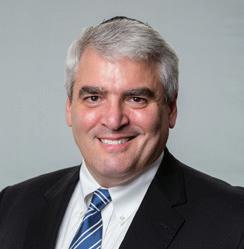

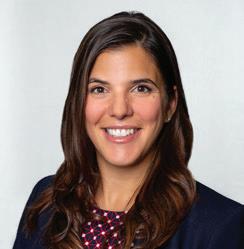











Fisher Brothers, a fourth-generation real estate company that owns, manages and operates unique spaces across the country, announced that funds affiliated with Blackstone Real Estate acquired a 46% jointcontrol interest in 1345 Avenue of the Americas at a full capitalization of $1.4 billion. Fisher Brothers, investing alongside Blackstone, also increased its majority ownership as part of the transaction. In addition, Fisher Brothers and Blackstone have completed a $850 million CMBS refinancing provided by Morgan Stanley, JP Morgan Chase and Citibank.
“This transaction reflects the tremendous value that premier, highly amenitized office buildings continue to offer to leading institutional investors, such as Blackstone,” said Winston Fisher, partner at Fisher Brothers, in the announcement. “The completion of the $850 million refinancing package enables us to continue to strategically invest in
the asset, while simultaneously increasing our ownership stake in the building. We remain bullish on the long-term Manhattan investment opportunity, which has been the hallmark of our family’s business for more than a century.”
Standing 50 floors above Midtown Manhattan and spanning two million square feet, 1345 Avenue of the Americas is 92% leased, with nearly 1.1 million square feet of leases signed since 2023 including the largest commercial office lease of 2023 when Paul, Weiss, Rifkind, Wharton & Garrison LLP took 765,000 square feet.
“Midtown Manhattan is the best-performing office market in the country, and we are excited to partner with Fisher Brothers in this trophy asset investment,” said David Levine, co-head of Americas acquisitions for Blackstone Real Estate.
In 2021, Fisher Brothers completed a $120 million large-scale capital improvement project with the help of Skidmore, Owings & Merrill, which included upgrades to the building’s exterior and lobby and a new amenity floor designed by Rockwell Group, @Ease 1345.
In both the acquisition and refinancing, legal representation for Fisher Brothers was Paul Hastings LLP, and Blackstone was represented by Fried Frank. Eastdil Secured LLC represented the joint venture in the refinancing. Lenders Morgan Stanley, JPMorgan Chase and Citibank were represented by Dechert LLP. Morgan Stanley also served as financial advisor to Fisher Brothers in connection with the acquisition.

units for low-income households, as well as two units for the building’s supers. The development features modern amenities, sustainable building practices and community-focused spaces designed to foster connection and well-being. Building E will include a telescope remotely controlled by Bronx High School of Science on the rooftop while a large central courtyard surrounded by the La Central apartment buildings will also be completed in this phase.

New York City Mayor Eric Adams, BRP Companies, Hudson Companies, J.P. Morgan and project partners broke ground on the second and final phase of the La Central housing development to bring 420 new affordable homes to the Melrose neighborhood of the Bronx.
Phase II will include a range of unit types from studios to four-bedroom apartments as well as 63 supportive housing units for formerly homeless New Yorkers. The new phase is expected to cost $343 million, with the Adams administration contributing over $137 million through the New York City Department of Housing Preservation and Development (HPD).
Phase II will include 13,000 square feet of community facility space, 1,500 square feet of retail and 7,000 square feet of new public gardens.
Upon completion in 2028, Phase II will offer a mix of affordable apartments reserved for households earning between 30% and 80% of the area median income. It will include 114 units for extremely lowincome households, 106 units for very low-income households and 198
“As we embark on bringing Phase II to fruition and move towards final completion of the La Central project, over 1,000 vitally needed affordable residences will have been created for the South Bronx as we strive to help fill the void in housing offerings across the city,” said Andy Cohen, managing director, BRP Companies.
The La Central development, comprised of five distinct buildings, delivers over 1,000 affordable housing apartments to the Bronx community. La Central Buildings A and B, which opened in 2021, are fully affordable, mixed-income, mixed-use developments with nearly 500 apartments. Building A is also home to a state-of-the-art YMCA. Building D, completed in 2019, provides 160 supportive and low-income apartments. La Central participates in the NYSERDA Multifamily Performance Program and LEED for Homes. The two new buildings created through the final phase will be designated Building C and Building E.
“Today’s groundbreaking marks a major milestone in our long-standing commitment to bringing much-needed affordable and supportive housing to the South Bronx and New York City,” said Marlee Busching-Truscott, managing director of development, Hudson Companies. “La Central has been over a decade in the making and will ultimately deliver over 1,000 high-quality and sustainable homes through an inclusive, communityfocused development.”

Kaufman Leasing Company consists of highly qualified professionals with a thorough knowledge and understanding of the New York City office, retail and specialty-use real estate sectors.
155 West 23rd Street
450 Seventh Avenue
100-104 Fifth Avenue
27-35 West 24th Street
13-15 West 27th Street
45-47 West 27th Street
19 West 24th Street
119-125 West 24th Street
111 West 19th Street
212 West 35th Street
132 West 36th Street
242 West 36th Street
237 West 35th Street
275 West 39th Street
462 Seventh Avenue
470 Seventh Avenue
519 Eighth Avenue
22 West 19th Street

www.kaufmanorganization.com

democracy, community center, locally focused retail and two hotels from Mohegan and the owners of the Banyan Tree hotels and resorts, complete with entertainment and modern gaming options for those 21 and over.

Freedom Plaza, a new civic and cultural plan for Midtown Manhattan’s East Side, officially submitted its license application to the New York Gaming Facility Location Board. With a projected $11.1 billion in total investment, Soloviev Group and its partner Mohegan are advancing a project that they say will transform Manhattan’s East Side while generating $3.2 billion in annual economic output.
The developers said the plan delivers more affordable housing than any other Manhattan proposal and is the only Manhattan project to offer open green space.
“This application represents years of meaningful listening and collaboration, and it will uniquely deliver what New Yorkers need most: accessible green space, housing that working families can afford and well-paying union jobs,” said Michael Hershman, CEO of Soloviev Group. "With ongoing input from our neighbors, labor partners and faith and civic leaders, we remain committed to building a project that creates lasting value for the community and all of New York City.”
Freedom Plaza will include 1,049 new residential units, including 513 units that working families can afford, and approximately five acres of public park space designed by OJB Landscape Architecture. The plan will also feature a food market, daycare, museum dedicated to
“Freedom Plaza reflects the core values that define us at Mohegan, including inclusion, opportunity and a deep commitment to the wellbeing of the local community,” said Ray Pineault, CEO of Mohegan. “With a centuries-long legacy of stewardship and community-building, we’re proud to partner with the Soloviev Group and collaborate with New York’s diverse civic, labor and faith leaders to help shape a destination where people can come together, thrive and share in lasting prosperity. We know New York City, we’ve been engaged in this market for decades and look forward to expanding our footprint and delivering a transformative experience for Midtown East.”
Designed by Big-Bjarke Ingels Group, the mixed-use development will be built entirely with union labor and directly support the creation of 17,000 high-quality, full- and part-time union jobs during construction and operations, with nearly 40,000 jobs supported overall throughout the economy. Project labor costs during construction are projected to generate approximately $1.5 billion alone. Thereafter, thousands of permanent careers in operations, hospitality, retail and entertainment will be sustained once open.
To ensure long-term, shared prosperity, the project introduces community-first investment models designed to keep financial benefits rooted in New York. Ownership in the proposed gaming facility will be opened to New York City residents, giving individuals the opportunity to share in the project’s long-term economic success. In addition, eligible New York state and city employee-related pension funds will receive preferential access to investment opportunities, enabling broader public participation in the economic upside of the development. The investment opportunities for New York City residents and these pension funds would commence no earlier than 2027.
The DOT will utilize the premises for warehouse and industrial space, vehicle and equipment storage, administrative offices and vehicle parking. The agency had previously occupied the space on a monthto-month license agreement while awaiting full approvals from the city. As part of the newly executed lease, the building will undergo significant capital improvements tailored to the city’s operational needs.


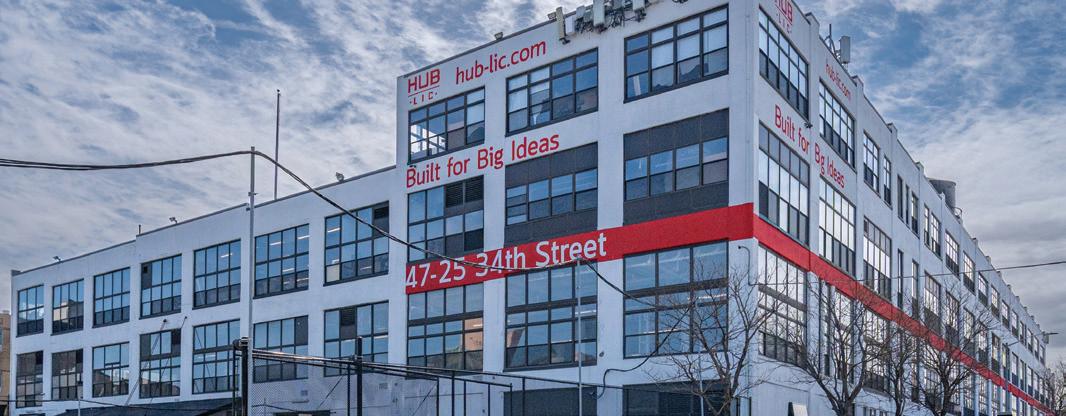

The New York City Department of Transportation (DOT) has signed a long-term lease at HUB LIC, located at 47-25 34th St. in Long Island City, N.Y., announced Joseph A. Farkas, CEO and founder of Metropolitan Realty Associates LLC (MRA). The 21-year lease covers 212,094 square feet across the entire ground floor, the entire second floor and a portion of the building’s exterior parking lot.
HUB LIC is owned in a joint venture between MRA and Nuveen as part of a long-term industrial investment strategy. The property was acquired in August 2016.
The 343,407-square-foot multi-level industrial building currently houses four tenants and is now 78% leased. Other tenants include TEC Systems, Satis&Fy, Metropolitan Office & Computer Supply Co. and Charles R. Gracie & Sons.
“The building’s strategic location for the Department of Transportation’s operations and the unique physical attributes of the property, including a one-acre parking lot, multiple loading docks and drive-in access with curb cuts, made HUB LIC the right ‘deal’ for DOT, and we welcome them
CBRE’s John Reinertsen, Yun Park, Doug Holowink, Josh Leibowitz and Michael Lee represented the Department of Citywide Administrative Services (DCAS) in the transaction. Scott Klau and Ryan Gessin of Newmark represented the landlord.





77% of future sellers believe they won’t need to drop their price, with nearly all (92%) saying they are certain their home will generate strong interest from buyers. However, just 77% of past sellers say their home generated strong buyer interest, and nearly a quarter (23%) say they received just a single offer on their home. Notably, just 5% of future sellers say they expect just one offer.

Dream on — nearly three-quarters of Americans who plan to sell their home in the next year (72%) are confident they will receive offers above their asking price, despite just 42% of recent sellers reporting this was the case, according to a report from Clever Offers, a Clever Real Estate platform that allows home sellers on tight timelines to explore their selling options.
In reality, 43% of recent sellers had to lower their asking price. Still,
Seller optimism is high: 93% believe they’ll price their home correctly, compared to 85% of past sellers who think they hit the mark. Likewise, 91% are certain they’ll choose the right agent — a stark contrast to the 74% of past sellers who feel they did. However, not every expectation is inflated. While 40% of past sellers accepted an offer within two weeks, only 18% of future sellers expect such a fast sale.
Additionally, although 56% of recent sellers spent less than $1,000 on unexpected costs, 82% of those preparing to sell are setting aside more. Only 31% of past sellers reported making unexpected concessions — yet 80% of future sellers say they’re prepared to compromise with buyers. Despite nearly all future sellers (94%) worrying they’ll make a mistake during their sale, just two-thirds of recent sellers (66%) actually did.
On a scale of one to 10, 63% of future sellers anticipate stress levels of seven or higher, while just 54% of recent sellers actually experienced that level of pressure.

“The 74 is a rare opportunity for buyers who want the best of Manhattan living: timeless design, privacy and a sense of community in the city’s most desirable neighborhood,” said Russo, who serves as director of sales for The 74.

Developer Elad Group, along with Douglas Elliman Development Marketing, announced that closings are underway at The 74 condominium, located on the Upper East Side.
Designed by Pelli Clarke & Partners with interiors by AD100 alumni designer Rafael de Cárdenas, The 74 offers full-floor layouts with 360-degree Central Park and skyline views, a duplex penthouse with expansive terraces and a singular townhome. Strong sales at The 74 reflect the demand for high-quality, contemporary residences on the Upper East Side, the team said.
“The 74 is designed to meet the expectations of today’s most discerning buyers and the lifestyle they want on the Upper East Side,” said Elyse Leff, executive vice president of marketing and sales at Elad Group. “We are delivering striking modern homes paired with the perfect suite of amenities.”
Douglas Elliman Development Marketing’s Barbara Russo, Danielle Englebardt, Elena Sarkissian and Christopher Salierno have been tapped to drive sales.
The tower’s pleated white terracotta façade and bronze-framed windows create a striking, contemporary silhouette that pays homage to New York’s Art Deco heritage. Inside, de Cárdenas’ interiors feature European White Oak flooring in an oversized parquet pattern, custom millwork and floor-to-ceiling windows by Polito Serramenti.
Kitchens are appointed with ash cabinetry, bianco ice marble countertops and backsplashes and fully integrated Miele appliances. Primary bathrooms offer Calacatta Vagli marble, custom Sycamore vanities and Dornbracht fixtures, while powder rooms are finished with Pink Namibia marble and brushed platinum accents.
The full-floor residences boast spectacular views of Central Park and the midtown skyline, with light streaming in from four exposures to create a bright, airy ambiance throughout the day. With total privacy and direct access to all of the building’s world-class amenities, these homes are a true rarity in Manhattan’s competitive real estate market.
Almost all of The 74’s amenities are positioned on the 17th floor to maximize natural light and city views. The fitness center, Pilates studio and lounge with wet bar offer residents inspiring views of the city skyline. The powder room on this level is bathed in natural light, underscoring the building’s commitment to elevating the resident experience.
Residents also enjoy a discreet lobby, private garden, library lounge and a children’s playroom.
Prices range from approximately $2.995 million for a two-bedroom to $13.55 million for a full-floor five-bedroom with Central Park views.
Incoco Capital, along with developers Tavros and Charney Companies, announced that Madison Realty Capital, Kushner Companies and OneIM have provided significant construction loan financing for its development of 24-19 Jackson Ave. and 45-03 23rd St. in Court Square, a 55-story condominium skyscraper which will begin rising in Long Island City.
The project is being financed with $425 million in backing from Madison Realty Capital, a vertically integrated real estate private equity firm, along with $100 million from Kushner, a multi-generational real estate development and management firm, and OneIM, a global alternative investment manager and Kushner’s capital partner.
It will bring 636 new units to Long Island City.
“We have successfully carried out numerous projects in New York in partnership with proven developers and global institutional investors, including Korea,” said Fa Park, chairman and founder of Incoco Capital. “We are also exploring EB-5 investment opportunities, given the project’s potential for job creation and broad economic impact.”
The project site was completed in 2022 when Incoco Capital acquired additional land from Japanese hotel chain Toyoko Inn for approximately $68.5 million, doubling the size of the original site, which had been assembled by Tavros and Charney since 2016.


“We’re very excited to commence construction on our Court Square building, which is set in a spectacular location with wide ranging views of Manhattan, Brooklyn, Queens, the East River and its bridges,” said Nicholas Silvers, founding partner of Tavros. “This is an extremely exciting time for us, and we’re grateful to both Madison Realty Capital and to Kushner for sharing in this exhilarating project.”
The architectural design is being led by FX Collaborative, and the residential offerings will include a diverse mix of units, ranging from studios to one- to four-bedroom residences. In addition to offering a premier amenities package, Chelsea Piers Fitness will occupy the building’s podium for 30 years, joined by Whole Foods for 15 years.
While economic uncertainties and stock market fluctuations may create strategic opportunities for sophisticated investors, the wealthiest U.S. households continue to see the greatest real estate gains, according to Sotheby’s International Realty in its recently released “2025 Mid-Year Luxury Outlook” report.
Beyond market dynamics, the report also delivered intelligence on financing strategies and natural disaster impacts on property values, and identified five emerging and re-emerging luxury property markets.
“The luxury real estate landscape continues to evolve at an unprecedented pace, creating opportunities for homebuyers and sellers with the right market knowledge,” said Bradley Nelson, chief marketing officer, Sotheby’s International Realty. “This report is designed to empower both homebuyers and sellers with the strategic intelligence needed to make informed real estate decisions throughout the remainder of the year.”
The report draws on insights from Sotheby’s affiliated agents worldwide who specialize in transactions in the US$10 million and up price category. Their expertise is complemented by data and analysis from UBS, J.P. Morgan, Moody’s, McKinsey and Company, Bain and Company, Cotality (formerly CoreLogic), the National Association of Realtors and the National Association of Home Builders.
Despite concerns about tariff impacts and economic uncertainty, May 2025 inflation data released by the Bureau of Labor Statistics beat economists’ expectations, said the New York Times. Sales of properties at US$10 million and above soared between February 1 and May 1, 2025, compared to that same period in 2024, according to analysis published in May 2025 by The Wall Street Journal.





In the U.S., the top half of the wealthiest households saw the biggest gains in real estate value among all homeowners in 2024, according to an April 2025 report by realtor.com.
Renewed confidence and momentum in San Francisco are driving sales. Sotheby’s International Realty–San Francisco brokerage closed several transactions over US$20 million in 2024, topping previous records. Puerto Rico’s highest recorded property sale grew from US$2 million to $30 million in a decade, according to local property records. The post-disaster market is experiencing increased interest, particularly where there are opportunities for rebuilding or new construction.
An April 2025 report by The Wall Street Journal found that wealthy individuals continue to move to locations that are at risk of climate events and are “setting home price records when they get there.”
“Ultra-high-net-worth individuals continue to view real estate as an essential portfolio component,” said Philip White, president and CEO, Sotheby’s International Realty. “Even amid economic uncertainty, the resilience of the luxury housing market provides compelling opportunities for strategic homebuyers and sellers.”
















MONDAY, AUGUST 4, 2025



The Seawane Club | Hewlett Harbor, NY
Rockaway Hunting Club | Lawrence, NY
Hempstead Golf & Country Club | Hempstead, NY




Sunrise Day Camp–Long Island is the world’s first full-summer day camp for children with cancer and their siblings, provided completely free of charge.
Sunrise Day Camp–Long Island is a proud member of the Sunrise Association, whose mission is to bring back the joys of childhood to children with cancer and their siblings worldwide. Sunrise accomplishes this through the creation and oversight of welcoming, inclusive summer day camps, year-round programs and in-hospital recreational activities, all offered free of charge. Sunrise Day Camp–Long Island is a program of the Friedberg JCC, a beneficiary agency of UJA-Federation of New York.





Jamestown announced that Levi’s Plaza, a nearly one million-squarefoot office campus located on San Francisco’s Embarcadero, has officially achieved net-zero operational carbon. The milestone makes Levi’s Plaza the first existing, large-scale commercial campus in San Francisco to achieve net-zero carbon operations.
“Net zero operational carbon isn’t just an environmental milestone — it’s a competitive positioning strategy,” said Michael Phillips, president of Jamestown. “Modern companies are actively seeking places that align with their own ESG goals, and our work at Levi’s Plaza positions the property to meet that desire. As we see more AI startups and innovation companies choosing the northern waterfront, this investment ensures we’re aligned with the businesses that will be significant players in San Francisco’s next economic chapter.”
The clean energy transition at Levi’s Plaza was achieved through a more than $50 million property retrofit that included several key measures. Fossil fuel-powered heating systems, including boilers and natural gas HVAC systems, were replaced with energy-efficient electric heat pumps and other electric alternatives as part of comprehensive electrification upgrades. In partnership with Wunder, Levi's Plaza installed on-site solar infrastructure totaling over 200kW of power across three buildings.
The campus also sourced 100% clean energy from CleanPowerSF, which provides electricity entirely from renewable energy projects such as solar or wind in the Bay Area and across California, as well as via







renewable energy credits using National Green-e Certified Wind RECs generated in the U.S. Remaining emissions were offset through highquality carbon offsets via the HFC Refrigerant Reclamation Project.
By removing its onsite reliance on fossil fuels, transitioning heating systems to electric alternatives and offsetting remaining emissions, Levi’s Plaza is fully aligned with San Francisco’s climate goals, including net-zero greenhouse gas emissions by 2040. Jamestown reaffirmed its commitment to the decarbonization of commercial properties globally.
Levi’s Plaza is Jamestown’s first net-zero operational carbon asset across its global portfolio.
The New York State Energy Research and Development Authority (NYSERDA) has awarded nearly $7 million to nine projects through the fifth round of the Buildings of Excellence Competition, which aims to advance best-in-class, energy-efficient multifamily buildings in New York. The competition provides financial awards and recognition for zero-emission or carbon–neutral-ready buildings.
“The Buildings of Excellence Competition continues to inspire replicable and scalable solutions, tapping into cutting-edge technologies that transform the way we design and construct buildings,” said NYSERDA President and CEO Doreen M. Harris.
Launched in 2019, NYSERDA’s Buildings of Excellence Competition provides financial incentives and recognition for the design, construction and operation of zero-emission buildings. NYSERDA has awarded 75 new construction and gut-renovation projects over five rounds of competition, with 41 located in disadvantaged communities. More than two-thirds of these new construction buildings serve affordable housing markets.
Seven of the nine buildings to be constructed will serve low- to moderateincome customers; six will serve disadvantaged communities. All of the projects are zero emissions and carbon neutral-ready and are committed to meeting a Passive House standard.
Eight projects incorporate solar generation; one includes energy storage.
Round Five awardees are:
• 77 William St.: BronxPro Group and Safe Harbors of the Hudson, Curtis + Ginsberg Architects in Newburgh, N.Y.
• Chester Agricultural Center Farmworker Housing: Chester





Agricultural Center, Inc, WXY Architecture + Urban Design in Chester, N.Y.
• 280 East 161st St.-West Tower: Gilbane Development Co. and Institute for Community Living, Aufgang Architects in the Bronx
• 475 State St.: Alloy Development, Alloy Architecture LLP and Thornton Tomasetti in Brooklyn, N.Y.
• Building 10 Bio-based Passive House (3989, 3995 Hillman, 4009 Gouverneur Ave.): Amalgamated Housing Cooperative, ZH Architects in the Bronx
• Kissena House: Selfhelp Realty Group, Curtis+Ginsberg Architects, in Flushing, N.Y.
• Powerhouse Apartments: Lemle & Wolff Development Co. LLC and HELP Development Corp. and True Development New York LLC, Ettinger Engineering Associates and STAT Architecture in the Bronx
• Seneca West 110th St.: Infinite Horizons LLC, Urbane Development Group LTD, Lemor Development Group LLC, and L+M Development Partners LLC, Curtis + Ginsberg Architects in New York, N.Y.
• 1707 Hertel Ave.: Forward Development LLC, Line 42 Architecture, PLLC in East Aurora, N.Y.


“It's not every day you have the opportunity to partner with a franchise that has been building trust since 1979,” said Ryan Parsons, CEO of Evive Brands. “Maid Brigade brings strong leadership under Raychel Leong-Sullins, a committed franchisee base and a stellar reputation earned over four decades. Together we see tremendous opportunity — from boosting top-line revenue to amplifying marketing — to help this mature brand keep growing. Even after decades of success, Maid Brigade still has room to become a true household name, and our team is committed to helping it get there.”





Evive Brands, a community of service-oriented franchise brands, has acquired Maid Brigade, a residential and commercial cleaning franchisor with more than 280 franchised locations across the United States and Canada. The transaction further expands Evive Brands’ reach in the home services sector; its portfolio (Executive Home Care, Assisted Living Locators, Grasons and The Brothers That Just Do Gutters) approaches 1,000 franchise locations nationwide.
Maid Brigade will continue to operate under its established name, with President Raychel Leong-Sullins and her leadership team guiding product innovation and franchise growth. Integration efforts will emphasize shared technology, training and marketing resources that should benefit all franchise owners across Evive Brands.
“Our PureCleaning system sets the standard for eco-friendly, peoplefirst cleaning,” said Leong-Sullins. “Partnering with Evive Brands connects our franchisees to additional operational expertise and crossbrand collaboration while allowing us to stay true to our communityfocused values.”






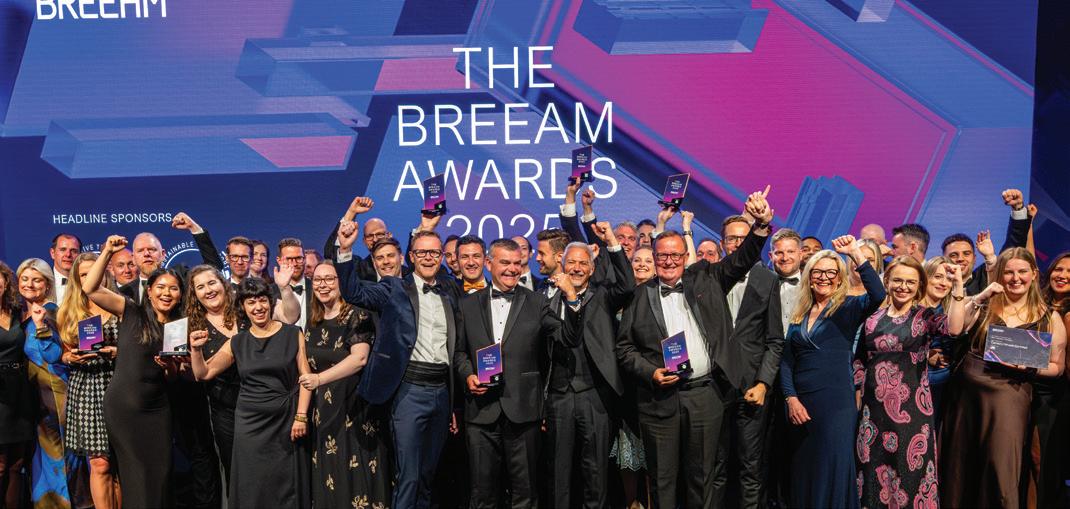
The Building Research Establishment (BRE) recognized significant achievements in the U.S. market at the 2025 BREEAM Awards, which honored the people and projects leading the industry in sustainable building design, development and management. Held in London, the awards brought together leaders from across the global built environment to celebrate accomplishments across BREEAM’s network, reinforcing the role of sustainability strategies in driving long-term value and resilience.
While the following U.S. nominees did not receive the top award in their respective categories, being shortlisted reflects an immense achievement and underscores the caliber of their work in advancing sustainability within the built environment. The 2025 U.S. shortlisted nominees include:
• DWS US Portfolio, GRESB Portfolio Integration Award
• PGIM Real Estate, GRESB Portfolio Integration Award
• CBRE Inc, Best Assessor Company
• Cushman & Wakefield, Best Assessor Company
• GreenGen, Best Assessor Company
• Iron Mountain Data Centers, BREEAM NC Commercial
• Chris Pennington, BREEAM ESG Outstanding Achievement Award.
This year’s U.S. nominees were recognized across several categories, reflecting the growing dominance of BREEAM as a science-driven framework for improving performance, operational excellence and value
creation in U.S. real estate.
“In today’s economic climate, real estate owners, investors and operators are under pressure to demonstrate the value and resilience of their assets,” said Breana Wheeler, U.S. director of operations at BRE. “The projects and professionals recognized at this year’s BREEAM Awards demonstrate what’s possible when sustainability goals are treated as drivers of operational excellence, and we’re proud to celebrate their achievements.”
The event also commemorated a major milestone for BREEAM and CitizenM, with the hospitality brand’s Menlo Park Hotel becoming the first hotel in the U.S. to achieve an Outstanding rating under BREEAM In-Use, the highest level of certification available.
Chosen as the hotel partner for Meta’s campus in Menlo Park, Calif., the Menlo Park property was designed to meet rigorous sustainability, well-being and efficiency goals. The project serves as a benchmark for sustainable hospitality in the U.S., demonstrating how early planning, data-driven decision making and stakeholder alignment enable highperformance outcomes in operational buildings.
These recognitions highlight BREEAM’s expanding U.S. footprint and its position as a trusted method for evaluating and improving building performance across all asset classes and lifecycle stages.
BREEAM has been a global sustainability assessment method for planning projects, infrastructure and buildings for over 30 years. There are now nearly three million BREEAM-registered buildings across 104 countries. In 2024, BREEAM saw robust expansion across North America, including a 43% increase in the total number of assets certified by BREEAM in the region.
BRE’s upcoming Version 7 update to BREEAM is set to drive progress across the commercial real estate sector by advancing sustainability efforts. With expanded carbon benchmarking, full lifecycle coverage and streamlined data collection, the update will allow users greater access to the latest built environment innovations grounded in a rigorous, sciencebased approach.
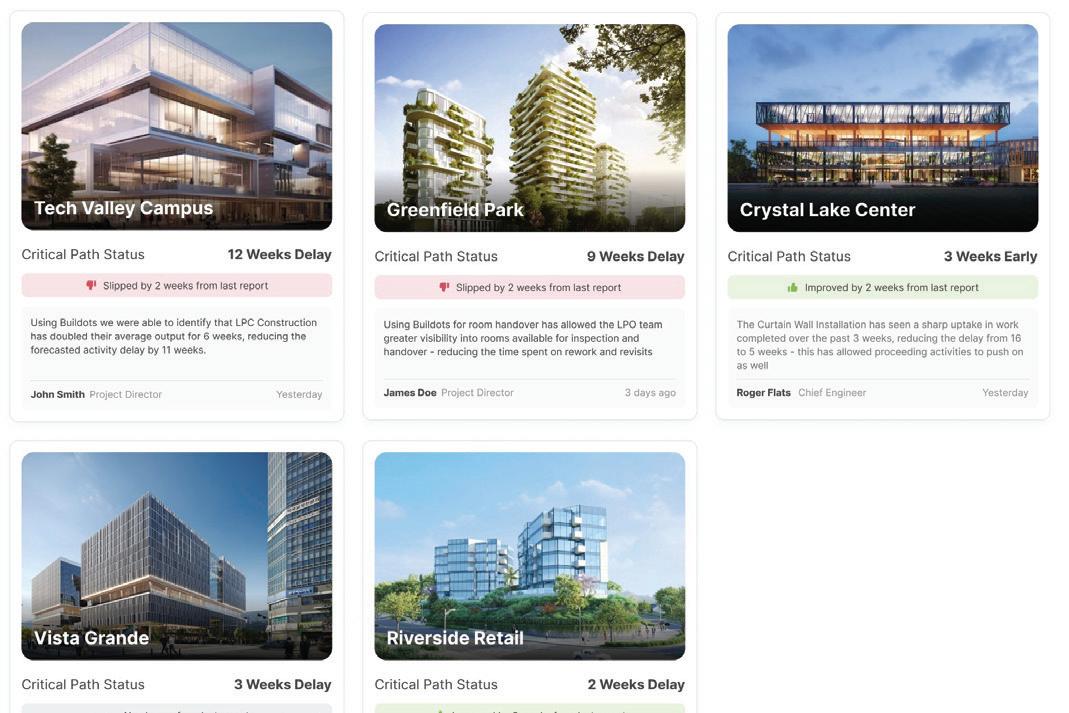
construction executives and their teams to shift from firefighting to foresight, allowing them to work together to more expediently and effectively assess the health of their projects and address issues before they cascade into major problems.”
Multiple subjective, disjointed sources of information and other variables, make understanding the status of projects at a glance difficult. This prevents them from identifying and acting on risks and issues before they become unmanageable and makes effective collaboration with site teams and other stakeholders extremely difficult.

AI construction technology provider Buildots announced the launch of Portfolio Dashboard, which it said provides construction firms with a unified, objective view across active projects. The Dashboard will enable construction executives and site teams to work together more effectively, expedite collaborative data-driven decision-making and improve cross-portfolio project outcomes, the company said.
Portfolio Dashboard provides a centralized, high-level view of all projects — combining status updates, trend insights and input from project leads on challenges and resolutions. It gives executives the visibility required to shift from reactive firefighting to confident, proactive portfolio control.
“At Buildots, our mission has always been to transform construction management through data-driven insights,” said Roy Danon, cofounder and CEO of Buildots. “With Portfolio Dashboard, we’re enabling
Portfolio Dashboard helps construction teams address these challenges in three core ways. Objective warning signals weeks or even months before problems escalate allow teams to shape outcomes rather than simply react to issues after they’ve grown too large to ignore. A single reporting format across all projects makes it easier to compare performance, identify outliers and allocate resources more effectively. AI-driven progress tracking provides impartial data on what's been built alongside project team commentary and mitigation plans that shed light on why things are moving or stalled.
The Dashboard provides a clear view of project status, progress trends and concise updates from project leaders. When deeper investigation is needed, teams can work together to see and understand which specific activities are driving delays and determine mitigation plans.
“Portfolio Dashboard gave me instant clarity on project health across the board," said Mark Bessey, regional director at Sir Robert McAlpine. “Instead of waiting on reports or chasing updates, I could see exactly where attention was needed and take action quickly. It helped us shift from reactive management to data-driven leadership.”
Portfolio Dashboard is currently available to select enterprise clients.

move also adds UrbanFootprint’s experienced product, engineering and customer-success teams, including founder and CEO Joe DiStefano.

LightBox, a platform powering location intelligence for the commercial real estate (CRE), lending and infrastructure industries, announced the acquisition of UrbanFootprint, a pioneer in geospatial analytics and scenario-based modeling for infrastructure investment, climate risk and community resilience.
The acquisition expands LightBox’s data portfolio with UrbanFootprint’s nationally modeled layers including demographics, land use, environmental hazards, infrastructure and social-equity indicators. This
“Our customers are navigating increasingly complex, high-stakes decisions about where to invest, build and mitigate risk,” said Caroline Stoll, general manager of data and analytics at LightBox. “By integrating UrbanFootprint’s powerful data assets and scenario-modeling capabilities, decision-makers can see not only what’s on a site today but how climate, demographic and infrastructure forces may reshape it tomorrow.”
Over the coming months, LightBox will weave UrbanFootprint’s models and data across its platform, enhancing site intelligence, underwriting analytics and property-level benchmarking for customers in real estate, finance, infrastructure and government.
“LightBox’s mission to connect commercial real estate through real-time intelligence reflects the vision we built at UrbanFootprint,” DiStefano said. “I’m excited to help carry that vision forward as part of the LightBox platform.”
LightBox, which serves an extensive clientele of over 30,000 customers, will continue to support UrbanFootprint’s utility, finance and government clients while introducing new opportunities across its expanding platform.
increase occupancy, improve resident satisfaction and scale highperformance operations across entire portfolios. The suite is designed to reduce team strain, increase occupancy, improve resident satisfaction and scale high-performance operations across entire portfolios.
The suite delivers intelligent, self-directed digital agents that do far more than automate tasks — they learn, adapt and act with purpose, freeing onsite and centralized teams to focus on what matters most: human connection and operational excellence, the company said.



Betterbot, a multifamily industry artificial intelligence (AI) automation platform, has launched the Betterbot Agentic AI Suite, a platform that introduces the power of agentic AI to marketing, operations and resident engagement. Simultaneously, the company revealed a comprehensive brand refresh that it said repositions Betterbot for its next stage of growth — one rooted in intelligent, proactive and humancentric automation.
The Betterbot Agentic AI Suite is designed to reduce team strain,
“This is not just a product launch — it’s a leap forward in what AI can do for multifamily,” said Zlatko Bogoevski, CEO and co-founder of Betterbot. “We’ve moved beyond reactive automation. The Agentic AI Suite enables proactive, intelligent and measurable performance across every facet of the renter lifecycle and portfolio operations.”
The suite includes three integrated tiers. Agentic Marketing is a fullfunnel leasing engine that powers 24/7 omnichannel engagement, AIgenerated websites and advanced lead intelligence.
Agentic Operations provides intelligent automation across the resident lifecycle, including renewals, maintenance triage, collections and service workflows. Agentic Portfolio offers enterprise-grade insight, custom AI Agent development and white-glove support for data-driven growth at scale.
“BetterBot’s new agentic AI isn’t just a tool — it’s an operational revolution,” said Dana Zeff, managing partner at Unit Leader LLC and a BetterBot investor. “For multifamily operators, this means fewer handoffs, faster leasing cycles and a dramatically leaner team footprint without compromising the resident experience.”

“We deeply understand the financial challenges currently affecting condo and homeowners’ associations throughout South Florida,” said BidMax CEO Richard Saccone. “With increased insurance costs and reserve obligations, many homeowners feel compelled to sell at prices lower than anticipated. Our primary aim is to ease these financial pressures by minimizing transaction costs.”

The service aims to substantially reduce transaction costs for homeowners who face financial pressures from rising insurance rates, reserve requirements and unexpected assessments.
Since launching in 2024, BidMax has streamlined real estate transactions through its fully automated, user-friendly platform. The platform simplifies the entire process, from listing homes on the MLS and syndicated websites, to managing communications, scheduling showings and negotiating offers — all in one digital location.
“Our advanced automation eliminates tedious busy-work and streamlines logistics,” Saccone added. “The efficiency we gain translates directly into cost savings, which we pass on to our clients, saving the average homeowner tens of thousands per transaction.”
Additionally, BidMax’s integrated partner app dispatches showings and open houses to licensed showing agents, who utilize an Uber-like application and are compensated on an hourly basis.
This approach ensures hands-on service without traditional high commission costs, enhancing the selling experience for homeowners.


















performance, rehearsal and studio space for community arts groups.

Gilbane Development, in partnership with Blue Sea Development, Artspace and the City and State of New York, announced $254 million in financing for the Brownsville Arts Center & Apartments (BACA).
Located at 366 Rockaway Ave. in Brooklyn, BACA will deliver nearly 263,000 square feet of residential space and a 28,000-square-foot cultural arts center that will serve as a community hub. BACA will offer a mix of 283 studios to three-bedroom apartments, affordable to households earning between 30% and 70% of the area median income (AMI), including dedicated units for formerly homeless individuals.
Rising on a vacant city-owned lot awarded for development through a competitive New York City Housing Preservation and Development (HPD) RFP process, BACA exemplifies the city’s “Brownsville Plan,” which aims to transform the community by pairing affordable housing with opportunities for cultural expression and community connection.
The financing includes nearly $100 million from the City of New York. At the heart of the cultural arts center is a 3,440-square-foot multipurpose
“Brownsville Arts Center & Apartments is a powerful expression of our commitment to equitable development through design, collaboration and community,” said Yarojin Robinson, senior vice president, affordable and mixed-income housing, Gilbane Development. “This project goes beyond housing — it’s a cultural and residential anchor that will uplift and inspire Brownsville for years to come. ”
Designed as an all-electric building, BACA targets PHIUS (Passive House Institute US) 2021 CORE, LEED Platinum, the Environmental Protection Agency’s (EPA) Energy Multifamily New Construction Program, EPA’s Indoor airPlus and Fitwel certifications, and has been recognized by the New York State Energy Research and Development Authority (NYSERDA) as part of its Buildings of Excellence and Building Cleaner Communities Competitions.
“It means a great deal to all of us at Blue Sea Development and Gilbane Development to be part of a project that treats cultural infrastructure and affordable housing not as separate needs, but as shared pillars of community life,” said Jacob Bluestone, Blue Sea Development Company. “When you pair affordable housing with dedicated cultural spaces to perform, practice and gather, you create more than a place to live — you create a place to thrive.”
Construction started in July 2025 and completion is expected in December 2027.
Gilbane Development, Blue Sea Development and Artspace serve as joint venture development partners, along with Gilbane Building as general contractor and Aufgang as architect.
“Our mission is to make the best risk data easily accessible to decisionmakers,” said Shubharoop Ghosh, vice president of data services at ImageCat. “Green Shield’s Property Guardian insights add a new dimension to our hazard data offerings, especially at a time when wildfire risk is escalating and affecting underwriting decisions across the U.S. and beyond.”



International risk management innovation company ImageCat announced a new partnership with Green Shield Risk Solutions, a provider of wildfire risk analytics and mitigation intelligence, to integrate Green Shield’s proprietary Property Guardian data into ImageCat’s Inhance and FACFinder platforms.
ImageCat serves the global risk and catastrophe management needs of the insurance industry, governments and NGOs. This new partnership will provide (re)insurers, financial institutions and real estate stakeholders with a new lens on wildfire exposure — combining ImageCat’s geospatial analytics with Green Shield’s on-the-ground, parcel-level intelligence.
Green Shield’s Property Guardian product delivers detailed parcellevel wildfire risk and mitigation data, ranging from defensible space assessments to vegetation and structural condition scoring. These insights are critical for evaluating property-level vulnerability and identifying actionable mitigation strategies.
“By embedding Property Guardian data into ImageCat’s platforms, risk managers can transition from general hazard awareness to specific, actionable intelligence,” said Brian Bastian, head of product at Green Shield Risk Solutions. “This partnership allows users to make betterinformed underwriting, investment and mitigation decisions with confidence in the granularity and credibility of the data.”
The integration will support a wide spectrum of users — from insurance underwriters and risk managers to banks and real estate portfolio owners — who rely on ImageCat’s platforms for real-time exposure analytics and high-resolution risk data.









































“We cannot predict the future, but we can prepare for it, and that is what Foundations for the Future does,” said CSHL President and CEO Bruce Stillman. “The ongoing expansion will help ensure that CSHL remains at the global epicenter of biology research and education for generations.”





Global construction and development firm Skanska and Cold Spring Harbor Laboratory (CSHL) celebrated the topping out of the Artificial Intelligence and Quantitative Biology (AIQB) building at CSHL. Skanska is providing construction management services for the $248 million, 379,500-square-foot campus expansion, which, upon completion of this first phase, will feature state-of-the-art neuroscience and cancer biology labs, an AI research building and a parking garage.
Phase II of the overall $500 million campaign calls for a new 81,000-square-foot research housing and conference center and a 56,000-square-foot housing and collaborative research center for visiting scientists. The project is supported, in part, by the New York State Empire State Development (ESD), which the lab has leveraged with private funds.
Substantial completion of the Foundations for the Future campaign initiative will be achieved in early 2027. The CSHL campus is recognized on the National Register of Historic Places.
The project involves a phased approach with multiple sub-projects progressing concurrently. The scope of operations includes the construction and fit-out of several key facilities: a 36,000-square-foot neuroscience research complex and a 28,000-square-foot AI and quantitative biology research building. A new, two-story, 90,000-squarefoot parking garage that will provide space for 225 cars is underway, along with the relocation of a campus roadway and existing utility infrastructure, including sewage, natural gas and other utility lines.
The three-story AIQB is built using mass timber glulam columns and beams with cross-laminated timber (CLT) floor decks. The timber used in the AIQB was responsibly sourced from sustainably managed forests in the Southeastern United States, and fabrication waste such as sawdust and scrap material was recycled and repurposed for other applications. The $28 million facility will house four laboratories, 15 principal investigator offices, 96 postdoctoral researcher workstations, seven research administration offices, three administrative offices and 10 meeting rooms.
“With roots dating back to the 1800s, CSHL continues to exemplify a longstanding commitment to progress, innovation, and building for the future,” said Sean Szatkowski, executive vice president, general manager, Skanska USA Building.

The new Life Time will feature:
• A luxurious, co-ed wet suite with steam rooms, saunas, hot tubs, and cold plunges.

Life Time announced a 52,000-square-foot lease agreement with Prop and Building Corp. (PBC) at 10 Bryant, a Class A Midtown Manhattan office tower, with an anticipated opening in early 2027.
The planned Life Time athletic urban country club will be housed within four levels at the 30-story tower at 10 Bryant, located at the corner of 40th Street and Fifth Avenue — directly across from Bryant Park and the New York Public Library.
“Bringing Life Time to 10 Bryant and the Bryant Park area is key as we grow our network of athletic country clubs throughout New York City,” said Parham Javaheri, chief property development officer and president of club operations at Life Time. “This vibrant, high-profile location offers the energy, visibility and accessibility we seek, allowing us to serve even more people with our breadth and depth of experiences from fitness to recovery to community building.”
• An expansive workout floor with top cardio equipment, resistancetraining machines and free weights. A dedicated recovery space will include cold and water massage chairs, whole body compression technology, percussion devices, metabolic testing, recovery treatments and nutrition coaching.
• Six boutique-style studios for group fitness formats including Fight Conditioning, MB360, GTX, Barre, Pilates and more.
• A dedicated Life Time Work Lounge for coworking and productivity.
10 Bryant is owned and managed by Prop and Building Corp., a real estate development and investment firm focused on transformational urban projects.
“Life Time represents a pivotal step in the repositioning of 10 Bryant, further enhancing its status as a premier destination in Midtown,” said Eli Elefant, CEO of Property and Building Corp. “Their commitment to wellness and innovation will not only elevate the tenant experience but also contribute to the building’s transformation into a hub for modern living and working. This partnership aligns seamlessly with our vision for the future of 10 Bryant.”
Life Time operates seven Manhattan locations — Battery Park, Midtown, NoHo, One Wall Street, Penn 1, Sky and 23rd Street — as well as two in Brooklyn at Atlantic Avenue and Dumbo, with more in development including Brooklyn Tower, which is also set for a 2027 opening.









By Debra Hazel


























Holland & Knight Partner Stuart Saft didn’t grow up thinking about becoming a lawyer — he didn’t have a plan for his future at all.
But with 50 years as a pioneering real estate attorney, he’s not only built a career, but he’s also building a legacy of teaching and mentoring generations of lawyers — while reminding them that there’s life outside the office.
Saft grew up the son of working-class parents in Brooklyn and Queens and went to Hofstra University.
“In addition to meeting my wife, Stephanie, Hofstra changed my life. I got involved in everything from planning events, creating a student senate, attending meetings with the administrators, arranging for big-name entertainment, writing for the school newspaper, and keeping the school open during the Vietnam protest riots by inviting experts to discuss the war and the Domino Theory,” he said. “It was fabulous — the things I learned at Hofstra are the basis of what I do every day, which is why I say that ‘It all started at Hofstra.’”
Saft had attended college with the help of Army Reserve Officers Training Corp, and his required military service loomed after graduation, during the height of the Vietnam War. Stephanie suggested he go to law school and enter the Army afterward.
“No one in my family had gone to college, let alone law school,” he said. But he listened.
After graduating from Columbia Law School, Saft entered the Army, serving in Newport News, Va. On leaving the Army as a captain, most of his classmates were already well into their careers, while he was just starting. He started at a small Wall Street firm where he focused on corporate and securities law.
“In those days, no one was thanking us for our military service. At that time, Wall Street firms did not do real estate transactions,” he said. After four years, a client asked him to represent them in making a second mortgage loan secured by a shopping center.
“I did not have a mentor but used my corporate skills to prepare and close the loan,” he continued. “I must have handled it correctly because the client kept sending me real estate transactions.”
Arriving early to one closing, Saft, representing the lender, sat with the borrower, a former Yale tax professor who was inventing the real estate tax shelter, and his experienced lawyer.
The borrower asked his attorney a question — and received an answer that sent Saft reeling.

Saft took the LSAT, sitting with students whose parents were


Saft took the LSAT, sitting with students whose parents were lawyers and had planned on being lawyers from childhood. (“I was too naive to be nervous about the LSAT,” he said.) He never imagined that he’d place in the 98th percentile.

“If the lawyer’s answer was right, everything I’d done as a real estate lawyer was wrong. So, I questioned him and he brushed me off,” Saft related.




Also a differentiator is how Saft’s practice focuses on work/life balance for its relatively young team — except for Saft, nearly everyone is under 50 years old.































Saft is determined to bring creativity and mentorship to new generations of real estate lawyers and personally trains young associates, considering it to be the most important work he does. “We have a collaborative practice.”

The former professor, however, wanted to know why Saft disagreed. After he explained his position, the professor agreed with Saft and asked his lawyer for his reasoning. “To this day, the lawyer gave the stupidest answer I’ve ever heard — he responded that he didn’t look at the documents until he put the closing report together.”
The next day the professor hired Saft to handle complex acquisitions, financings and leasing and structuring the tax aspects. Eventually, word got around that Saft was a young real estate attorney who understood tax law. Saft worked on over 150 tax shelter transactions until the laws changed, and all of his deals held up on audit.
Because so little was written about complex real estate transactions, Saft started writing about them, eventually publishing 100 articles about real estate, tax, economics and finance. Writing books was an accident. He was approached by a publisher to write a book about tax shelters, but Saft demurred and convinced the publisher that what was needed was a book explaining real estate transactions with forms and analysis.
As a result, Saft wrote “Commercial Real Estate Forms,” which started at three volumes, grew to 11, and which he has updated and supplemented for 37 years. He then wrote and supplemented “Commercial Real Estate Transactions,” “Commercial Real Estate Leasing,” “Commercial Real Estate Workouts,” “Real
Estate Investors Survivors Guide” and “Real Estate Development: Strategy for Changing Markets.” Since 2019, he has also been writing Client Alerts about the unintended consequences of legislation and regulations affecting real estate.
He represented Aetna and Chase in construction and permanent financing and then in a recession, his practice turned to workouts and bankruptcy. He then represented Tony Goldman, a visionary, in Goldman’s work reinventing Soho with loft conversions.
“One day Tony walked into my office to negotiate a ground lease, and we started to talk about reusing older buildings,” Saft said.
“In a sense, he taught me what has become ‘adaptive reuse,’ and I started doing the offering plans.”
A stint serving as president of his own co-op board led Saft to the board of the Council of New York Cooperatives and Condominiums. He then worked with then-Congressman Chuck Shumer assisting low and moderate-income co-ops in Brooklyn, and with Queens Borough President Claire Shulman and Manhattan Borough President Virginia Fields saving affordable co-ops from foreclosure. This led to his friendship with Chuck Synder, the president of the National Co-Op Bank (NCB). Saft served on NCB’s board of directors for 12 years including three years as a chairman. He did the debt restructuring of Co-Op City, and the rebuilding of 12,000 apartments in Parkchester.
When another recession hit, Saft started working with developers. He was the proponent of the Chapter 11 plan to get Cityspire out of bankruptcy and completed its construction including crawling around the roof of the building seeking the source of a whistle that was heard around the city. He completed the workout and completion of Worldwide Plaza, including climbing onto the parapets on the 45th floor seeking the cause of spalling bricks.
“I wound up representing the developers because I understood their business and was committed to writing plans that facilitated the sale and the operation of the building and found I loved the development side because it unleashed my creativity,” he said.
He became a partner in his first law firm after five years and left two years later to launch his own firm with two colleagues, which eventually grew to 25 lawyers. After another recession, he built a real estate practice within a larger firm. A need for a larger platform led him to LeBouef Lamb, which then merged with Dewey Ballantine. Ultimately, Saft became Dewey & LeBouef’s global head of real estate.
At home, his civic work continued, including serving as president of the NYC Private Industry Council (formed under the federal Job Training Partnership Act) and then working with the federal government to establish the Workforce Investment Act. He formulated New York’s Workforce Investment strategy and chaired NYC’s WIB Board for 12 years under Mayors Guiliani and Bloomberg.
The day after 9/11, he held a meeting in his midtown office with city, state and federal workforce officials to plan for the anticipated job losses from the terrorist attack. A week later, Mayor Guiliani sent him to DC to meet with New York’s Congressional delegation. After a three-hour meeting with Senator Hillary Clinton, she and Senator Schumer were able to obtain a $20 billion commitment from President Bush to rebuild New York City. Saft received commendations from the National Association of Workforce Boards and Mayor Bloomberg for his work.
While building his practice, Saft honed the training philosophy and program he uses today — one in which his door is always open, questions are welcomed and young attorneys’ work/life balance is supported. Much of it was based on his own personal experience, from the lack of support his banker wife experienced when their sons were young. He brought that philosophy to Holland & Knight in 2012. In 13 years, he helped build Holland & Knight’s New York City real estate practice from five lawyers to 60, working on $11 billion in transactions in 2024.
Saft is determined to bring creativity and mentorship to new generations of real estate lawyers and personally trains young associates, considering it to be the most important work he does. “We have a collaborative practice.”
Also a differentiator is how Saft’s practice focuses on work/life balance for its relatively young team — except for Saft, nearly everyone is under 50 years old. Approximately half of the attorneys are women, and Saft ensures that new parents don’t lose their work while on maternity or paternity leave. The rest of the team divides the work until their colleague returns, and the returning attorney gets back their entire portfolio of work.
“I learned with my own children that they are young for only a brief period of time so if you miss it, there is not another chance,” Saft continued. “There will always be another deal. I want the parents to spend time with their kids, attend their games and meet their teachers.”
Saft arrives at the office at 6:30 a.m., leaves at 6:30 p.m. and has no intention of retiring, ever. One other note: no one has ever heard Saft scream at anyone, ever, although there is a lot of laughter coming from the 30th floor of 787 Seventh Ave.
There’s a picture of one more child in Saft’s office — one of himself as a 10-year-old Cub Scout.
“I keep this picture of myself to remind me who I really am,” he said. “If you are successful, you can easily forget who you are. Young Stuie keeps me grounded so I never forget who I am and whence I came. I may be older, but I will always be that kid from Brooklyn and Queens who went to Hofstra.”





In today’s fast-moving and increasingly complex financial environment, successful business owners need more than just an advisor—they need a trusted partner who sees the full picture, anticipates change, and integrates every facet of their financial world. For over 30 years, Louis C. Ciliberti & Associates has delivered exactly that.
We are a full-service financial firm and multi-family office that helps the most financially successful individuals and privately held companies in the nation. At Louis C. Ciliberti & Associates, we don’t just provide advice—we orchestrate and execute a total wealth strategy that aligns with our clients’ business goals, family needs, and long term vision.





By Craig Gillespie, CEO of Airtower Networks


The remote work standard was short-lived. But it wasn’t long ago, in the early days of the COVID-19 pandemic, that companies were giving up their leases, canceling their landline phones and moving to a fully remote workforce; a workforce with BYOD (bring your own device) phones and laptops that was fluid and dynamic, capable of working at any time and any place.
In the post-pandemic era, CEOs have rapidly concluded that a fully remote workforce lacks the ability to creatively problemsolve and work efficiently as teams. The productivity gains from the dynamism of working anytime and anywhere were offset by the sheer lack of presence and real-time interactions.
Recently viewed as the future of the working world, remote work policies have once again taken a back seat to the more traditional, in-office model.
Heading into 2025, we saw more companies and organizations — from Fortune 500s to the U.S. federal government — rolling back remote work approaches and bringing employees back to the workplace, either on a full-time or a hybrid schedule.
In 2024, companies with fully remote policies dropped to 25% (from 31% the year before), while the average number of days required to be in office increased to 2.78 per week, according to a Forbes report.
As the return-to-office boom continues, companies are finding communication technologies from the pre-pandemic world to be archaic. Cable modems, SIP trunking and PBX phone lines are being phased out, as businesses refocus their IT stack on more modern in-building connectivity solutions that complement a hybrid workforce. These include fast fiber, pervasive Wi-Fi and expansive cellular coverage that enables sales calls to be made, whether in the parking garage or the conference room.
It is in this context that connectivity has taken on the role as the “fourth utility” — but unlike a utility, it can sometimes be unclear where responsibilities lie between the owner/occupier from both an operational as well as economic perspective. Where it has become common for the responsibilities of other utilities to be called out in lease agreements as gross, triple net, etc., connectivity often falls through the cracks and can create friction in the owner/occupier relationship.
As office leasing evolves, strong connectivity has become a key factor in tenant decisions and retention. Ensuring reliable connectivity is no longer the sole responsibility of tenants, landlords or brokers — it’s a shared effort.
Historically, the responsibility for wireline internet access has fallen almost entirely on the occupier, whereas the owner is responsible for providing building entry access agreements and maintaining building risers and conduit. Wi-Fi access points, with a few exceptions, have traditionally been put entirely on the shoulders of occupiers.
Cellular, on the other hand, was once entirely driven by wireless carriers and, to this day, most owners and occupiers believe an inadequate cellular signal is the responsibility of the MNOs (mobile network operators) to rectify. But to the chagrin of owners and occupiers alike, carriers have largely pulled back from providing capital to in-building projects, leaving a significant gap in responsibilities.
Further complicating the issue is when environmentally minded retrofits (e.g., LEED windows) or nearby building developments block a formerly strong radio frequency signal from entering a building, creating a problem without an easy solution.
Sophisticated owners/occupiers now realize that they are on the hook for determining a cellular solution themselves, but the responsibility for operational and economic costs is unclear. The challenge with cellular lies in provisioning and device access. When boosting cellular coverage within an office space, a stronger signal is available pervasively, regardless of the amount of usage and by whom, operating much like a common-area amenity.
It is also generally cost-effective to scale a cellular coverage system across multiple floors or an entire building rather than managing unit by unit. This further incentivizes the landlord to invest in an end-to-end solution. This shared accessibility further blurs the lines of responsibility.
Collaboration is becoming more common. Many occupiers are now working with tenant reps from property managers to ensure wireless infrastructure is in place before leases are signed. For example, before signing a significant long-term lease, prospective tenants often work through their tenant rep to make sure their lease includes a cellular DAS (distributed antenna system) that would provide an adequate 5G signal.
All stakeholders — tenants, landlords, and brokers — have a role to play. Tenants need reliable wireless to drive operations, landlords benefit from an increased property value through higher rents and greater occupancy and brokers need to ensure connectivity is addressed in negotiations. Recognizing this shared responsibility promotes transparency, cost-sharing discussions and better longterm planning.
Cost-sharing mechanisms vary based on lease terms, tenant needs and the building’s structure, but the benefits can go beyond splitting expenses.
A landlord’s investment in core technology, such as boosting cellular coverage, can be a major marketing asset. Strong connectivity attracts tenants, and landlords can incorporate these costs into common area maintenance (CAM) charges. This ensures all tenants contribute to the upkeep and enhancement of wireless capabilities.
At the same time, businesses can invest in connectivity upgrades specific to their operational needs — whether it’s private LTE, advanced Wi-Fi or other tailored solutions. This two-tiered approach ensures comprehensive coverage for the building while allowing tenants the flexibility to optimize their workflows.
At Airtower, we’ve seen that scope and budget play critical roles in tenant decisions. In some cases, tenants opted against leases because all in-building wireless technology needed to be addressed. In other scenarios, landlords who had previously invested in cellular upgrades expanded those systems with more antennas and coverage units during tenant turnover.
Because all businesses and buildings are unique, there’s no one-size-fits-all model for cost sharing. But incorporating connectivity discussions and shared investment into lease agreements benefits everyone involved.
When evaluating a property, start by running a speed test on your phone to get a baseline for cellular performance. Ask about available fiber infrastructure and whether cellular signal boosters or DAS are already in place or can be added. Most importantly, work with your tenant rep to include cellular and DAS requirements in your lease to avoid costly surprises down the road. Engaging early and asking the right questions helps ensure the space is equipped to meet modern connectivity demands.


By Amanda Stanaway, Director and Global Head of User Strategy, ERA-co



We often talk about culture, values and peoplefirst thinking — but how does it really translate? For me, it comes down to workplace character: the authentic expression of a company’s vision and values through its physical environment.
In today’s world, the workplace is no longer somewhere people have to go — it’s somewhere they can choose to be. That shift has changed everything. It’s raised the stakes for organizations


to create environments that not only attract talent but also deliver a clear business advantage — by strengthening culture and improving connection and, in turn, trust and performance.
Workplace character is a strategic asset. When done well, it aligns culture, performance and purpose, ensuring the workplace acts as a stage for genuine connection, shared values, innovation and results.

Designing a workplace isn’t just about aesthetics or planning. It’s about understanding people, particularly what inspires them to show up and give their best. Too often, we’ve reduced engagement to metrics or technology platforms when, in reality, the physical environment plays a pivotal role in how connected and motivated people feel.
Space can organically influence behavior. When we design with intention, meeting rooms transform from sterile boxes to dynamic settings that reflect the type of interaction they’re meant to host. Hallways evolve from mere thoroughfares to thoughtful transition zones where spontaneous exchanges happen naturally.
Even the placement of amenities can draw people into parts of the workplace they might not otherwise visit, creating serendipitous connections across departments. These subtle design decisions shape how people move, interact and collaborate without the need for explicit direction.
That’s workplace character in action. And it’s not accidental. It’s intentional, and it requires deep listening and bold thinking.
When we design for character, we design for culture — not the kind of culture written on a wall but one that is imbrued in the lived experience and physical space (place). It’s about translating the intangible aspects of organizational culture into tangible spatial elements. The physical environment becomes a three-dimensional expression of company values, telling the story of the organization in how it supports different ways of working, how it encourages curiosity and how it says to people, “This is the mission, and this is your place.”
The highest-performing workplaces are ones where people feel seen and supported. That alignment — of values, people and place — is where performance thrives. When employees experience consistency between what an organization claims to value and what the workplace enables them to do, trust develops and engagement deepens, acknowledging today that the “workplace” is one of many tactics needed to be optimized to enable high-performance teams.
Workplace tactics and character start at the top. A thoughtfully designed workplace tells employees, “We care about your experience. We believe in your potential.”
When leadership is involved in shaping space, not just signing off on it, it shows. There’s a tangible connection between the business’ intent and the daily lived experience of employees. That kind of alignment builds trust and creates a shared sense of purpose — one of the most powerful drivers of engagement.
The value of design, and how exemplary strategy and design linked together can be organizationally and culturally
powerful, have been underestimated. One of the clearest signals an organization can send about what it values and how it supports its people is by linking business visions, values and mission to the physical space — using tactics within the physical environment to support and drive behaviors of high performance, connection, collaboration and innovation.
Robust workplace character will increasingly become a powerful tool in attracting and retaining talent because, when designed well, the physical working environment becomes a strategic support.
Meeting spaces positioned for visibility encourage spontaneous collaboration. Quiet zones with appropriate acoustic treatments signal respect for focused work. Flexible settings that can be reconfigured by users empower teams to adapt as their needs change. Through these intentional design decisions, the workplace becomes a tool that links business vision, values and mission to everyday experiences.
Workplace character becomes a powerful tool in attracting and retaining talent. It gives people a reason to engage more deeply, to stay longer and to bring more of themselves to the table.
In a world where flexibility is expected, people return to the spaces that feel grounded in something tangible. The workplace becomes not just where work happens but how work happens best.
Workplace character is a critical part of the enablement of workplace strategy. Rather than seeing it as a backdrop, we should leverage it as a living part of company culture and a powerful tool, especially as we encourage users to utilize the physical office as a part of cultural cohesion and connection.
The best workplaces respond to how people actually work, not just how we think they should. They provide settings that support different tasks and work styles while feeling authentic rather than prescribed, with elements that reflect the unique character of the teams that inhabit them.
When we approach design with curiosity and care, we stop creating spaces for roles and start creating places for people. And that’s where performance flourishes — in workplaces that don’t just look good but feel right. That’s the future.
At the end of the day, work is deeply human. It’s where we spend a huge portion of our lives, so the environments we create should reflect that truth. They should be places where people can think, connect, grow and be challenged — in ways that feel meaningful.
As we look ahead, the opportunity isn’t just to build smarter offices. It’s to lead with empathy. To craft spaces that embody the unique character of each organization — and that, in turn, inspire people to do their best work. Engagement isn’t forced. It’s felt.
By Jose Reyes, AIA, NCARB, LEED AP BD+C Director of Science + Technology, AO

ASdigital transformation reshapes the global economy, the demand for data centers has never been greater — or more complex. From powering everyday cloud storage and streaming services to supporting the explosive growth of artificial intelligence, data centers are the critical infrastructure behind our digital lives. Their design, however, is anything but standard.
The architecture of today’s data center must evolve in step with rapid shifts in technology, regulation and sustainability. Across regions and facility types, one-size-fits-all approaches no longer apply. Instead, successful data center design hinges on the convergence of four key principles: smart design, technical fluency, environmental responsibility and deep collaboration.
Smart Design: Scalability Is the New Standard
As workloads become more dynamic and rack densities continue to climb, scalability is now a baseline requirement in data center design. Smart architecture not only accommodates today’s needs, but it also anticipates future capacity and performance demands.
Modular design strategies — both horizontally and vertically — enable phased buildouts, accelerate delivery timelines and help operators to future-proof their facilities. In urban markets, where real estate is constrained, multi-story solutions are becoming more prevalent. These facilities require thoughtful planning around vertical circulation, mechanical, electrical, plumbing and technology pathways and structural loading. The best designs align operational efficiency with architectural flexibility, offering a framework that can evolve without compromising uptime.
Technical Fluency: Navigating Local Complexity
Data center development is highly contextual. Regulatory frameworks vary widely across geographies, from emissions thresholds to land use restrictions. In hotbed markets like Northern Virginia, data centers are now at the forefront of policy conversations around energy consumption, environmental impact and community integration.
beyond this metric. With increasing scrutiny on energy and water use, forward-looking designs now emphasize holistic resource stewardship.
Passive architectural strategies — such as optimized building orientation, envelope performance and shading — can reduce mechanical loads. Low-water or waterless cooling systems, rainwater harvesting and greywater recycling offer viable paths in water-stressed regions. And as operators pursue cleaner energy portfolios, facility designs must accommodate solar integration for the administrative office areas and alternative fuel sources for backup generation.
Architectural teams that prioritize systems thinking, working in lockstep with MEP engineers and sustainability consultants, can deliver not only more efficient facilities, but more resilient ones as well.
The pace and complexity of data center projects demand a highly collaborative process. Too often, teams are brought together in silos, with designers and contractors each working from different assumptions and priorities. This disconnect can lead to inefficiencies, misaligned scopes or delayed schedules.
Architects must be fluent in these regional nuances. Translating abstract technical and operational goals into code-compliant, constructible solutions often requires close coordination with planning departments, utility providers and acoustic or environmental consultants. This complexity is further magnified when pursuing phased development, requiring a balance between current capacity needs and longterm site planning.
While power usage effectiveness (PUE) remains a key benchmark, sustainability in data centers has expanded far
Best-in-class data center design brings the entire team to the table early. That includes owners, consultants and contractors, each with a clear understanding of the facility’s goals, site conditions and operational parameters.
In new or international markets, local expertise is especially crucial, not only for navigating entitlements, but for understanding workforce dynamics, materials sourcing and climate resiliency strategies.
When collaboration is front-loaded and intentional, projects benefit from more coordinated documentation, tighter cost control, and more informed decision-making across the board.
Data centers may be highly technical structures, but they also represent a unique design challenge: how to balance performance, flexibility and environmental responsibility in a rapidly shifting landscape.
As demand surges and expectations grow, the most successful projects are those that embrace change as a catalyst — not a constraint.
At AO, we implement these best practices every day — on real sites, with real constraints, for real clients. From suburban hyperscale campuses to complex multi-story urban facilities, our work puts these
strategies into action and proves their effectiveness.
Our interdisciplinary teams collaborate closely with clients, engineers and contractors to deliver data centers that are operationally robust and forward-thinking in their design and sustainability performance.
As the digital world continues to evolve, so too must the architecture that supports it. AO is proud to be at the forefront of this evolution, shaping the future of data center design through a foundation of innovation, technical excellence and enduring partnership.


By Bentley Zhao, Chairman and CEO, New Empire Corp.






The Science of Happiness at Home Happiness begins at home. Recent data from the American Human Development Index quantifies this truth, measuring what matters most: health, education and economic opportunity. Statistics show families choosing neighborhoods where children grow up healthier, commutes are less taxing and the view from your window inspires dreams beyond the Manhattan skyline.
On a 10-point scale, the well-being index reveals that Long Island City posted a nearperfect well-being score of 9, while Sunnyside registered 7.21 and Woodside came in at 6.36. Together, the three neighborhoods averaged 7.52, marking a significant jump from the 5.97 average they posted in 2015. They ranked higher than the Queens boroughwide average of 7.3 and well above the New York City average of 6.14.
More striking still, the average life expectancy across the three neighborhoods climbed to 86.4 years, up from 85.4 years in 2015. Long Island City and Sunnyside both posted an average of 87.2 years, nearly five years longer than the citywide average.
This extraordinary transformation validates what discerning residents have discovered about Western Queens' unique combination of luxury, community and genuine quality of life.
At our Centric condominium in Sunnyside East, we have witnessed this evolution firsthand. The recent record-breaking $1.512

There is a new narrative unfolding in New York City real estate, and nowhere is it more evident than in Queens. This past quarter, Queens shattered its own record for average sales price, with one- to three- family homes now averaging over $1 million for the first time ever, a milestone confirmed by the latest residential brokerage reports released in July. Underscoring this momentum, the median asking price and the number of homes for sale in Queens posted the largest year-over-year percentage increases compared to Manhattan and Brooklyn. In just the past year, homes in Queens appreciated by an impressive $196,400. Meanwhile, Manhattan has slipped from being the nation’s third most expensive housing market in 2019 to not even cracking the Top 10 today.
These achievements are a testament to the borough’s transformation into a destination where luxury, well-being, and investment opportunity converge. The shift is unmistakable. Queens is rising, and the numbers prove it.
million sale, the highest residential price in both Sunnyside and Woodside history, was less about square footage and finishes, and more about a three-bedroom penthouse where 1,280 square feet of outdoor terraces frame panoramic Manhattan views. These homes remind residents daily why they chose this life, this home and this neighborhood where well-being flourishes.
As developers, we’ve learned that luxury amenities serve genuine lifestyle needs rather than as status symbols alone. The extensive suite of amenities at Centric creates environments where happiness occurs naturally, from private gyms and co-working centers that support health and career flexibility, to rooftop terraces and pickleball courts where neighbors become friends. These are intentional investments in the daily moments that exemplify the measurable wellbeing attributes of Western Queens, where energy translates into genuine life satisfaction.
When viewed through the lens of well-being research, the transportation access that has long defined Western Queens’ appeal takes on new meaning. The express 7 train and Long Island Rail Road connections from Woodside and Sunnyside East provide efficient commutes that deliver the gift of time — time for morning workouts, family dinners and actually using those community amenities that foster personal fulfillment.
Median personal earnings were highest in Long Island City at $106,500, one of the top figures among nearly 200 neighborhoods
citywide, further evidence that this connectivity enables residents to maintain roots in neighborhoods that prioritize quality of life while pursuing career opportunities across the metropolitan area.
From an investment perspective, the fundamentals are more compelling than ever. The surge in home values, record-breaking sales and rising demand signal a market that rewards both residents and investors. As the developer behind Centric in Woodside, Radiant and The Neighborly in Long Island City, and over 120 residential projects throughout New York City, I am most proud of having provided what is now a measurable framework for families to prosper. When families choose our developments, they are investing in neighborhoods where the data confirms what their instincts already knew.
The well-being scores rising across Long Island City, Sunnyside and Woodside reflect the natural outcome when thoughtful development meets authentic communities, when luxury amenities serve genuine lifestyle needs, and when homes are designed around how people live. The eastward expansion of Western Queens represents a real estate opportunity as well as the chance to be part of neighborhoods where happiness isn't accidental, it’s measurable. Where home isn’t just where you sleep, but where well-being begins.
As we look ahead, our commitment to building communities where well-being thrives will only grow stronger.



Cityview, the vertically integrated real estate investment manager specializing in multifamily, is coming east, opening a New York City office with a plan to strategically expand its investment and capital raising strategy beyond its existing Western and Southwestern U.S. markets into Boston, Orlando, Fla. and Atlanta as a start, followed by Raleigh, N.C. and Charleston, S.C.
“Cityview has historically focused on supply constrained markets on the West Coast, and in recent years we’ve diversified our strategy to include more demand-driven centers across the Southwestern U.S., including Dallas and Phoenix,” said Sean Burton, CEO of Cityview. “Now, we’re expanding nationally with a strategic move into East Coast markets that show strong fundamentals and are poised for future growth.”
To identify its top East Coast markets, Cityview partnered with Rclco Real Estate Consulting to conduct a comprehensive, data-driven analysis of the largest U.S. metropolitan statistical areas (MSAs). The objective was to identify highpotential markets for multifamily investment based on historical performance, current fundamentals and forward-looking economic forecasts based on 55 key data points.
Boston was chosen for its high level of professional employment and education, which creates a stable foundation for demand. New deliveries in the market are low relative to demand and projected future supply and Boston also showed a high level of stability – with the lowest total return volatility of all markets in the dataset, Cityview said.
Orlando consistently ranked in the top quartile among the dataset, showing strong positive exposure to demand and relatively small negative exposure to supply. The market’s strong employment and population growth along with its business-friendly environment help drive its strong performance.
Atlanta showed some of the strongest demand fundamentals in the companies’ analysis. Both
employment and population growth drove demand in the market higher than many peers.
In addition, Atlanta ranked first in average annual return over the past decade and in the top five for average annual sales volume –indicating strong capital market interest.
“Cityview will bring our extensive experience navigating complex supply constrained markets such Los Angeles to markets with similar fundamentals on the East Coast, particularly Boston,” said Damian Gancman, chief investment officer at Cityview. “We will also pursue high-growth markets with strong long term demand drivers such as Orlando and Atlanta, which we believe are close to absorbing excess supply and are on a path for strong vintage years given their continued growth.”
Founded in Los Angeles, Cityview has invested some $6.5 billion in more than 150 projects across the country and operated and developed nearly 20,000 units in 17 markets. It manages approximately 8,000 units, with more than 2,900 units under development. The company also has an office in Dallas.
Cityview’s new office in New York City is headed by Christoph Donner, the firm’s global head of capital development and strategy. He also heads the firm’s investor relations team and serves as a member of Cityview’s investment committee.
Donner joined the firm in January after previously serving as CEO of Pimco Prime Real Estate LLC, where he actively invested in markets both on the debt and equity side across the East Coast. The new office space is located at 300 Park Ave.
“This is an exciting time of rapid, strategic growth for Cityview,” said Donner. “We look forward to bringing our fully integrated investment management expertise and commitment to uncompromising operational excellence to the Eastern U.S. as we expand our platform nationally."




Please contact Neil B. Garfinkel, Managing Partner, to see how AGMB can assist you. Abrams Garfinkel Margolis Bergson, LLP is a full-service law firm dedicated to smart, practical and cost-effective counsel.

B. GARFINKEL, ESQ.
Broker Counsel to REBNY Abrams Garfinkel Margolis Bergson, LLP (212) 201-1173
Efax: (646) 778-3710 ngarfinkel@agmblaw.com www.agmblaw.com

Carol A. Sigmond Partner
Greenspoon Marder LLP
1345 Avenue of the Americas Suite 2200
New York, NY 10105
carol.sigmond@gmlaw.com (212)524-5074
Since the advent of the second Trump Administration, tariffs have been a source of confusion. At this point, the average tariff is 15.6%. The uncertainty surrounding tariffs is going to continue into 2026, which will impact the costs of routine and capital maintenance for multifamily buildings, including residential cooperative and condominium buildings.
Absent action from Congress, the courts will be adjudicating various tariffs under the Trade Expansion Act of 1962 (Section 232), the Trade Act of 1974 (Section 301), the International Emergency Economic Powers Act (IEEPA) and the Reciprocal Trade Agreements Act of 1934.
The most problematic and highest tariffs currently in effect are the IEEPA tariffs imposed on April 2, 2025. Two courts, including the United States Court of International Trade (CIT), have ruled that the IEEPA tariffs are unlawful as the president lacks the authority to impose tariffs under the IEEPA.
The imposition of tariffs is not one of the powers granted to the president under the IEEPA. Those rulings are pending review by the United States Courts of Appeals for the Federal Circuit and the District of Columbia Circuit. The Federal Circuit ordered an expedited briefing and scheduled oral argument, en banc, for July 31, 2025.
The Federal Circuit will likely affirm the CIT decision. It is also likely the Federal Circuit will stay its ruling to permit the government to appeal to the Supreme Court. At this writing, whether the Supreme Court will grant certiorari on the IEEPA cases is unclear.
President Trump has other tariff options. Section 232 is only available for national security purposes. It is not a general-purpose tariff statute. Section 301 is only available to counter unfair trade practices by other nations. We should expect Section 232 tariffs to be challenged as being too broadly applied, as well as Section 301 tariffs that are being challenged on procedural grounds.
Besides the Section 301 tariffs imposed on China, which are based on China’s economic protectionism against the United States, many of these tariffs are not likely to survive judicial scrutiny. These cases will
take at least a year to wind through the CIT and the Federal Circuit.
To the extent that tariffs are ultimately invalidated, the money will not be returned to consumers but will be returned to the importer. The importers may have other tax implications from the return of the funds and, in any event, may have no meaningful ability to return the tariff payments to customers if no special arrangement is made in advance.
Also, keeping the tariff refunds increases the importers’ profits.
While the courts sort out the tariffs, prices for goods containing aluminum, steel or both will increase. For multifamily housing, this is not a good development. It means that most household appliances, such as vacuum cleaners, dishwashers, washing machines and stoves, will increase in price. Additionally, windows with steel or aluminum frames and mullions will increase in price.
Likewise, steam and water valves, electric panels and PTAC units will be more expensive. Construction materials such as drywall studs, brick ties, electric conduit, plumbing pipes and valves, HVAC units and boilers will be more costly.
Delaying such purchases and related maintenance projects for a year or two would be wise. It may not always be possible, but capital projects should be evaluated against the tariffs, since these payments will likely be blocked in part in 2026.
The other force driving up construction costs is a developing labor shortage. Prior to the current push to deport undocumented workers, up to one-fifth of the construction labor force was undocumented. With pressure on undocumented workers, fewer may be available to work, meaning that either labor rates increase to attract U.S. workers or jobs slow down.
Either way, the cost of construction will increase.
Costs will not stabilize until the labor force and tariff issues are settled.
This column presents a general discussion. This column does not provide legal advice. Please consult your attorney for specific legal advice.

Frank DeLucia Executive Vice President
Hub International Northeast frank.delucia@hubinternational.com (212)338-2395
Water damage continues to be one of the most frequent and expensive causes of property loss for both commercial and residential real estate. A study by The Hartford found that water damage is the second most common insurance claim filed by small to mid-sized businesses, with an average claim cost of $17,000. For larger commercial properties, the cost of remediation, repairs and downtime can be significantly higher, especially when business operations or tenant occupancy is disrupted.
Beyond repair expenses, water damage can result in additional liabilities — from mold issues and structural weakening to lost rental income and reputational damage. Given the rising costs of materials and labor and increased risk due to extreme weather events, the need for a proactive approach has never been greater.
Implementing a formal water damage mitigation program can significantly reduce your exposure, improve response times and limit the severity of loss in the event of a water-related incident.
Understanding where water damage originates is key to preventing it. Damage can be caused by both external and internal sources. External sources include heavy rain and snowmelt, flooding and coastal storm surges, groundwater seepage, broken municipal water mains and HVAC system malfunctions or roof drain backups.
However, most commercial claims stem from internal issues such as burst or leaking pipes; sewer backups and clogged drains, malfunctioning appliances (e.g., dishwashers, refrigerators, coffee machines); overflowing fixtures such as sinks and toilets or corroded or aged plumbing infrastructure.
In colder climates, frozen pipes during the winter can rupture and cause extensive damage in a matter of just minutes.
To minimize water-related risks, real estate owners and managers should adopt a structured and propertyspecific water damage mitigation program.
A comprehensive plan should include the following elements:
1. Designate emergency response personnel. Identify and train key on-site staff responsible for initiating emergency procedures during a water event. These individuals should know how to locate and shut off water sources, contact emergency services and begin damage mitigation steps.
2. Assign a program leader. Appoint a member of senior management as the program’s lead or “process owner.” This person is accountable for maintaining the plan, ensuring training is up to date and supporting designated staff throughout implementation.
3. Identify buildings and customize plans. Each building within a portfolio should be individually assessed and included in the program. Site-specific differences such as plumbing systems, critical
infrastructure and tenant use must be considered when developing procedures.
4. Use water detection and monitoring tools. Consider installing water detection sensors in highrisk areas such as mechanical rooms, kitchens or near HVAC systems. Smart leak detectors paired with automatic shut-off valves can help identify and stop leaks before significant damage occurs.
5. Label and test shutoff valves. All water shut-off valves should be clearly labeled and mapped, including those hidden in ceilings or maintenance closets. Valve locations should be documented with photos and floor plans. Valves should also be regularly tested to ensure functionality.
6. Identify and protect critical areas. Create a list of rooms and spaces with essential equipment or operations that are highly sensitive to water damage, such as data centers, electrical rooms or tenant server spaces. Consider additional safeguards like raised flooring, water barriers or containment trays.
7. Establish clear communication protocols. A streamlined communication plan is vital. Roles and responsibilities should be clearly defined, including who notifies the insurance provider, building occupants and restoration vendors. Quick communication minimizes response time and accelerates damage control.
The majority of water damage incidents are preventable. Proactive strategies can make a measurable difference in both loss prevention and claim resolution.
Having a mitigation plan not only reduces physical and financial loss but can also positively impact your insurance coverage. Insurers often view welldocumented risk management efforts favorably, potentially leading to lower premiums or broader coverage terms.
Moreover, working with a knowledgeable insurance advisor ensures that your policy aligns with your risks. For example, some standard property insurance policies exclude certain water-related events unless specifically endorsed.
A broker can help you evaluate these gaps and recommend personalized coverages such as flood insurance, equipment breakdown or business interruption protection.
Water damage poses a serious and increasing threat to property owners and managers — but it’s also one of the most controllable risks. By investing in a customized water damage mitigation program, you can protect your buildings, safeguard tenants and preserve your bottom line.
Don’t wait for a costly loss to uncover vulnerabilities. Collaborate with an insurance advisor on a mitigation plan tailored to your buildings and risk profile.
The investment in prevention today can save you tens — or even hundreds — of thousands tomorrow.



From financing considerations, to property performance metrics, today’s real estate business is inundated with both challenges and opportunities.
PKF O’Connor Davies has decades of experience working with a variety of assets including industrial, office and residential sites. Our experience in this complex field gives us the expertise to deliver strategic advice that drives real value.
With the PKF O’Connor Davies Real Estate Team, our clients know greater service, know greater insights, Know Greater Value.

Edward O’Connor, Partner 201.712.9800
eoconnor@pkfod.com


Kris Kiser
Outdoor Power Equipment Institute
TurfMutt Foundation Equip Expo
1605 King St. Alexandria, VA 22314 turfmutt.com opei.org (703)549-7600
According to new research conducted by The Harris Poll for the TurfMutt Foundation, a good school system isn’t all buyers want in a new home. The green space in the neighborhood is also critical.
This survey was conducted online within the United States by The Harris Poll on behalf of The TurfMutt Foundation from April 15 to 17, 2025, among 2,075 U.S. adults ages 18 and older.
This research underscores the value of an investment in public green spaces and park systems for communities that wish to attract more people to their area. Parks also have become genuine environmental assets, from pollinator and wildlife support to carbon sinks and mitigating urban head islands.
The research shows 89% of Americans consider a good public park system a top community amenity, revealing the undeniable power of parks. Nearly all Americans (96%) utilize public green spaces, like public parks, for recreation. A vast majority (89%) feel communities should prioritize providing these spaces for community health and well-being.
The research proves that people want green space in their communities—and a lot of it. Poll findings include:
• 92% of Americans want more or better maintained public green space, such as public parks, school yards, dog parks, sports fields, etc. in their community.
• 75% would prioritize public green space when looking for a new home.
• 67% would be willing to pay more to live in a community with public green space over one without it.
Roughly three-quarters of Americans (74%) find public green spaces more valuable than other community amenities, such as an indoor pool, indoor fitness center or indoor recreation center.
The TurfMutt Foundation's research shows 96% of Americans enjoy participating in activities in public green space but also highlights the diverse ways in which people use them.
• Top public green space types that Americans want to see more of or see better maintained in their communities include parks (56%), running/walking trails (55%) and picnicking facilities (43%).
• Physical activities, such as taking a walk/ run (76%), playing/watching a sport (47%), working out (36%) or playing/watching an outdoor game (35%) are enjoyed in public green spaces by Americans.
• Immersing oneself with the outdoors is also among the commonly enjoyed activities in public green spaces, including connecting with nature (60%), observing wildlife (51%) and gardening (31%).
• Many Americans are using public green spaces for socializing activities such as having a picnic/dining outdoors (53%), letting their dogs socialize (32%) or bringing their kids to play (30%).
Louisville — the hometown of Mulligan the TurfMutt spokesdog — has more than 100 parks and recreational spots, making it an extraordinary example of a community prioritizing park systems for the health and well-being of its community.
Louisville’s Waterfront Park, where the TurfMutt Great Lawn is located, was just named No. 1 Riverwalk in the United States in the USA Today 2025 Readers’ Choice awards.
The sampling precision of Harris online polls is measured by using a Bayesian credible interval. For this study, the sample data is accurate to within +/2.5 percentage points using a 95% confidence level. This credible interval will be wider among subsets of the surveyed population of interest.
Check out the TurfMutt Foundation’s “International Backyarding Fact Book” to learn more about the power of parks and other green space around us. Sign up for Mutt Mail, a monthly e-newsletter with “backyarding” tips and all the news from the TurfMutt Foundation. Look for Mulligan the TurfMutt on the CBS “Lucky Dog” television and “Mission Unstoppable” shows on Saturday mornings.






Debra Hazel Communications North Las Vegas, NV 89084 (201)618-5247
ICSC Las Vegas isn’t just about networking and dealmaking — it’s also a time for some serious research. CBRE surveyed more than 50 retailers, landlords and investors at the conference about how the industry is adapting to a volatile landscape. Some answers were surprising, others not. But, despite challenges old and new the survey respondents revealed an optimism about the future — if all parties work together and flexibly.
According to respondents, consumers, uncertain about the short-term future, are being more cautious with their purchases and focusing on wellness goods and services. Freshness is a major consideration. More than 40% of those surveyed cited health and wellness/fitness as the retail category with the most momentum.
Lingering effects from the pandemic continue to influence shopping patterns, especially frequency. A quick trip to your local organic grocer or spa is made easier by still-ongoing hybrid work arrangements, and allow people to pop in and out closer to home during the day. Largely, though, shoppers are consolidating their trips.
“Responding to these new consumer behaviors, retailers are actively rightsizing and reformatting their stores,” the report said. “With fewer shopping trips and more targeted purchases, large urban flagships are giving way to smaller, more efficient suburban locations. These changes ripple into real estate decisions, requiring landlords to accommodate a broader mix of formats, from hybrid concepts to micro-locations with high visibility.”
As a result, smaller markets are seeing a boost in absorption, including in some interesting locations. Yes, major markets such Chicago, Houston and Philadelphia have seen the greatest absorption of space, between two million square feet and 2.5 million square feet in the fourth quarter of last year, followed by Dallas, which had between 1.5 million square feet and two million square feet of absorption.
But secondary markets including Cincinnati; Long Island, N.Y.; Tulsa and Oklahoma City, Okla.; Austin and Forth Worth, Texas; Las Vegas; Orange County Calif.; St. Louis and West Palm Beach, Fla. all saw between 500,000 square feet and one million square feet absorbed in the same period.
Clearly, retailers are going where the people are — closer to their suburban homes.
To accommodate smaller, more affordable (and potentially more profitable) spaces, retailers are increasingly using technology to improve their operations. Artificial intelligence is being utilized to
examine shopper behavior, allowing retailers to offer product recommendations and targeted marketing to its best consumers. Technology can help retailers predict demand and optimize stock levels, advise on adjusting prices and offering shoppers 24/7 support. All of this can free up store associates’ time to build real relationships with customers.
I remember when it was a big deal that a Nordstrom, for example, could find an item that was out of stock in New Jersey, and ship it from a Utah store to Florida in time for an event. (I loved that dress.) This takes that sort of service to the millionth level.
“AI has moved from innovation to expectation and, contrary to common fear, is enhancing, not replacing, the retail workforce,” the report observed.
And all of this guidance is never more necessary, when each day comes with a new political headline that can make the industry more uncertain, from tariffs to layoffs that can affect whether what had been a solid customer base — government employees — will have discretionary income at all.
Even so, the report is optimistic. When asked about a trend that will matter more in 2026 than today, nearly one-third of respondents (32.7%) cited expansion, especially health/fitness, retailtainment and service-related, followed by right-sizing and smaller footprints, at 26.9%.
That gives retailers and developers of new space, which remains historically minimal but I hear is ticking up slowly, some real opportunities, if the space is built correctly.
Flexibility, proactive planning and adaptable strategies will be necessary for retailers to get through the storms. Landlords, too, must do their part to help, seeing their tenants as partners, and creating flexible shells that can combine many different uses under one roof or in one complex.
“Retail real estate must evolve in step with the consumer. Spaces must be flexible, tech-ready and strategically located in markets with strong housing and economic fundamentals,” the report said. “Demand continues to shift toward smaller-format spaces in suburban areas and emerging markets, often tied to experience-driven brands and more health-conscious products.”
Retail real estate has always been the sector closest to its users — the customer is, was and always will be king. Right now, the consumer is in a bit of a selfprotection mode. Retailers and landlords can protect themselves by creating adaptable spaces that can accommodate ever-changing consumer needs.
Langsam Property Services Corp. is a Bronx-based real estate management company. These buildings are located in the Bronx, Manhattan, Queens, Brooklyn, and lower Westchester County.
Langsam is designated as an Accredited Management Organization (AMO), a standard of excellence in management conferred by the Institute of Real Estate Management (IREM).
1601 Bronxdale Avenue
Bronx, New York 10462
Tel: 718. 518. 8000
Fax: 718.518. 8585

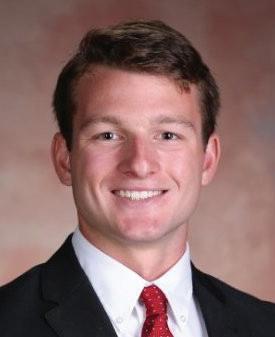
Investing in multifamily real estate can be lucrative, offering steady income streams and long-term capital appreciation. However, it also comes with a unique set of tax implications, and navigating the ever-changing taxation landscape for multifamily properties is crucial for investors aiming to maximize their returns and stay compliant with the law. This article explores several key aspects of multifamily real estate taxation.
One of the most significant tax advantages of investing in multifamily real estate is depreciation. Under the Internal Revenue Code (IRC) Section 167, the value of a building (but not the land) can be depreciated over 27.5 years for residential properties.
throughout the exchange process. Even in a properly executed 1031 exchange some states may still require taxes to be withheld from the sale of property.
The 1031 exchange strategy enables investors to leverage their gains to acquire larger or more lucrative properties without immediately incurring a hefty tax bill.
The IRS classifies rental real estate as a passive activity, meaning losses from these activities can typically only offset income from other passive activities. However, there are two exceptions under IRC Section 469.
One Citizen's Plaza, 9th Floor
Providence, RI 02903
(409) 626-3200
Additionally, some components of the property may qualify for a depreciable life of less than 27.5 years, such as five, seven or 15 years, accelerating depreciation expense. This allows investors to deduct a portion of the property’s cost each year, reducing their taxable income.
Mortgage interest is another major deduction available to multifamily property investors. Under IRC Section 163, the interest paid on loans used to acquire or improve the property can be deducted from rental income, reducing the overall tax burden.
However, real estate investors should be aware that under IRC Section 163(j), interest expense can be limited, reducing the allowable deduction in the year the interest was incurred. The good news is that there are several planning opportunities that can help mitigate the impact of 163(j) interest limitation on the real estate industry.
Investors can deduct various operating expenses associated with managing and maintaining a multifamily property. These may include property management fees, repairs and maintenance, utilities, insurance, legal and tax preparation fees and property taxes. Careful consideration must be given when deducting repairs and maintenance expenses; some may need to be capitalized rather than expensed. Investors can reduce their taxable income by diligently tracking and claiming these expenses.
A powerful strategy for multifamily real estate investors is the 1031 exchange. This allows investors to defer paying capital gains tax on the sale of a property if they reinvest the proceeds into a similar, like-kind property within a specified timeframe.
To qualify for a 1031 exchange, the replacement property must be identified within 45 days of the sale, and the purchase must be completed within 180 days. Sellers must utilize a qualified intermediary to facilitate the collection and distribution of funds
First, if you actively participate in managing the property and your adjusted gross income (AGI) is below $100,000, you may be able to deduct up to $25,000 of passive losses against your non-passive income. This allowance phases out for AGIs between $100,000 and $150,000.
Second, real estate professionals who spend more than 750 hours per year and over 50% of their working time materially participating in real estate activities can offset passive losses against other income without limitation. The complexities surrounding real estate professional status are not discussed here in detail; special consideration should be used in determining real estate professional qualifications.
In addition to federal taxes, multifamily real estate investors must navigate state and local tax obligations. Property taxes, which are levied by local governments, can vary widely by location and significantly impact the profitability of an investment.
State income taxes also impact an investor’s profitability. The $10,000 limit often impacts the deduction of state income taxes from a taxpayer’s federal income on state and local taxes claimed as itemized deductions. If real estate is owned by a passthrough entity such as a partnership or S corporation, in some cases, state income taxes may be paid at the entity level to allow for a deduction from federal income over the $10,000 cap. These are known as pass-through entity taxes and vary by state.
The taxation of multifamily real estate is complex, but with careful planning and the right strategies, investors can optimize their tax positions and maximize their investment returns.
Investors should work closely with an experienced tax advisor specializing in the complexities of the tax code and regulations pertaining to rental real estate.


Bob Knakal Chairman and CEO Group Leader
BKREA
787 Seventh Ave., Suite 3100
New York, NY
(917)509-9501
The results of the Democratic primary election recently sent shock waves throughout the city. Could a self-proclaimed socialist/communist really become the mayor of Gotham? Time will tell, but strategy sessions are going on all around town.
Much of Zohran Mamdani’s agenda seems radical, but if elected, he would only be able to implement a small percentage of his ideas. The state legislature is in control of many of those items and the mayor has virtually no ability to impose his will on them. Others require City Council action, and they are often at odds with the guy in charge.
Mamdani has said he wants to significantly change the way our multifamily housing market works. NYC has a complex rent regulation system that essentially limits the supply of new housing, creates a housing shortage and makes NYC less affordable for everyone as these dynamics drive rents up.
New supply of housing is the solution to our housing crisis. No one can look past the fact that during the pandemic, people fled the city in droves, driving vacancy up, which is essentially an addition to supply. Rents in Manhattan dropped by 30% based upon this “new” supply.
So why don’t policy makers encourage the creation of more housing? Because they want to protect their own jobs. New housing brings new people into their districts who don’t know them and might not vote for them.
Mamdani wants to expand rent stabilization to all new production as it existed under 421a, so New Yorkers get more in return than what is currently required through programs like MIH and 485x. Fortunately, this would require state legislative action and amendments to 485x, 467M, 421 preservation programs, 421 completion deadline projects or other similar programs.
Mamdani is also proposing a $100 billion investment to build 200,000 new, permanently affordable, union-built housing units over the next 10 years and major investments in existing public housing (NYCHA). His plan calls for the fasttracking of any 100% affordable developments and a commitment to fully staff agencies like HPD, DCP and NYCHA.
Sounds good, but where does the money come from? This proposal would require the state legislature to increase the city’s debt ceiling by more than $30 billion and a removal of the city’s volume cap for affordable housing bond financing by the federal government. City Council and agency involvement would also be required for zoning approvals and budget allocations.
Mamdani has also pledged to keep rent-stabilized rents frozen for four years. His control and influence over the Rent Guidelines Board could make this happen. This could be devastating for buildings where a majority of the units are rent-stabilized.
For many years, allowable rent increases have not kept up with inflation. Expenses are growing faster than income. Net operating incomes are decreasing year over year.
And with the Housing Stability and Tenant Protection Act of 2019 (HSTPA)’s marginalization of the MCI and IAI programs, there is no incentive for the private sector to invest in the housing stock. A rent freeze could be devastating for these buildings.
In 1978, the dilapidation rate in NYC housing was 14% — 14% of our housing units were deemed uninhabitable. The MCI and IAI programs created a huge incentive for the private sector to invest in the housing stock. By 2019, the private sector had dumped tens of billions of dollars into the housing stock and the dilapidation rate fell to 0.04%. Both of those programs have effectively been wiped out by the HSTPA.
The fact that our policy makers are thwarting new supply has exerted such upward pressure on free market rents that some buildings are able to hang on by a fingernail. Many, without a healthy free market percentage, have seen all equity evaporate and their mortgages are significantly impaired.
What will happen when the financial operations are saddled with a rent freeze for four years? For rational thinkers, the answer is obvious.
More important for our real estate market is how unfriendly the investment environment may become. Will crime drop when police are replaced with social workers? Will quality of life rise or decline? Will companies stay if their tax rates go up to 11.5% and do the rich stay if their city tax is raised by 50% as Mamdani pledges?
What will happen to cap rates? Cap rates are highly correlated to the flow of capital. If capital doesn’t want to come here or stay here, cap rates will go up and property values will go down.
The silver lining: if Mamdani wins, it may get so bad in New York that it opens up the possibility of a probusiness and pro-real estate mayor to get elected. Just like the bad old times under David Dinkins led to an era of Guiliani and Bloomberg, this may lead to the same result.
Time will tell, and the election is a long way off, but one thing is for sure, never bet against New York!


Ira Meister
President and CEO
Mathew Adam Properties Inc.
375 Pearl St. , 14th Floor
New York, NY 10038
(212) 699-8900
imeister@matthewadam.com
They are an unsightly intrusion in the cityscape. Pedestrians cross the street to avoid them, while others find shelter from brief summer rainstorms. Merchants and restaurants say they can reduce business. We’re talking about building scaffolding, which seems ubiquitous in midtown Manhattan and many high-rise residential areas.
After years of public frustration and anger, the City Council recently passed a package of five bills geared to limit the time the structures are up, improve their look and open the door for changes in the city’s Local Law 11, which mandates periodic safety inspections of building façades.
“Ask any New Yorker and they’ll tell you: sidewalk sheds are the permanent guest that never leaves,” said Council Member Erik Bottcher in a statement.
There are currently over 8,400 scaffolding structures in New York City, according to city estimates. The majority are concentrated in Manhattan, and the average age of scaffolding in New York City is over 500 days — 334 scaffolding structures have been in place for more than five years.
The package of bills:
• Requires the Department of Buildings (DOB) to recommend new sidewalk shed designs to the council by September 30, 2025. The legislation allows more color options for sheds, requires corresponding construction fences to match the color of the sidewalk shed, increases lighting beneath sidewalk sheds and raises the minimum height of sheds from eight to 12 feet, barring areas where exits, light or ventilation would be obstructed.
• Reduces the duration of sidewalk shed permits for façade repairs from one year to three months, unless the building can prove financial hardship, had problems accessing a neighboring property or had other issues impacting necessary repairs at a building. Exempt from the three-month timetable are projects connected to demolition, a building alteration or new building construction.
• Creates new penalties for property owners who delay repairs for sidewalk sheds occupying the public right-of-way. Penalties would begin with the second permit renewal and increase based on the size and age of the shed.
When renewing a shed permit, owners must now provide proof of work done since the last
renewal or provide documentation to explain any delays.
• Charges the DOB to review Local Law 11 and the currently mandated frequency of façade inspections, and recommend changes by December 31, 2025. This bill sets parameters to extend the inspection cycle from the current five-year interval to a longer time between six to 12 years, and delay the first required inspection for new buildings from five to nine years.
Owners who identify unsafe conditions during inspections of building façades will have five months to submit construction documents, eight months to submit necessary permit applications and two years to fully conduct façade repairs or be liable for penalties.
• Doubles the required level of lighting under sidewalk sheds with LED lights.
• Introduces penalties for failure to submit construction documents to DOB within five months of completion, failure to file necessary permit applications within eight months and failure to complete repairs within two years. Property owners would be able to seek extensions by submitting documentation proving delays are unavoidable.
The new scaffolding package is the latest in a series of legislation passed over the years. The first such bill dates from 1885, the same year the Statue of Liberty arrived in New York Harbor. The bill established safety standards for workers and liability for owners. It has been followed by other legislation regulating the construction of scaffolding and safety issues.
While there have been ongoing efforts to revise the law, the Scaffolding Law of 1885 has retained much of its intended purpose and was last amended in 1969. There apparently is no similar law in the country that seeks to protect construction workers faced with the inherent dangers of the job.
Early scaffolds were primarily made of wood and used for building and repairing structures. Over the years, the introduction of metal scaffolding in the early 20th century improved safety and durability as the construction boom in the 1920s and 1930s led to more complex scaffolding systems to support taller buildings.
Today, scaffolding is often made from steel and aluminum, offering greater strength and flexibility.



















Matt Ellis
CEO and Co-Founder
Measurabl
302 Washington St. San Diego, CA 92103
The proposed elimination of Energy Star (EStar) under the U.S. administration’s Fiscal Year 2026 budget has pushed the real estate industry beyond contingency planning to contemplate its energy and sustainability future like never before.
While perhaps best known for appliance labels, EStar’s often-overlooked component, a software product called Energy Star Portfolio Manager (ESPM), acts as the backbone of energy and sustainability data management and benchmarking for North American commercial real estate.
ESPM has supported more than 330,000 buildings across 35 billion square feet — allowing users to upload building data and receive a “1-100” benchmark, along with other value propositions.
It powers green loan programs from HUD to Fannie Mae, supports compliance with 60-plus state and local building energy performance standards and facilitates reporting across the ecosystem. It also underpins the EStar certification program, helping qualified owners distinguish their buildings through energy efficiency.
Offered at no cost to users (taxpayers cover it), ESPM has delivered significant returns — $350 in energy savings for every $1 invested, according to EPA estimates. A phenomenal ROI by any measure.
But as the government signals its intention to pull the plug, the real estate industry must consider an unprecedented question: If a new way forward is needed, what should that look like?
It’s a question the industry was initially uninterested in asking. EStar seemed too big and bipartisan to challenge — or so went the consensus. Many argued it couldn’t live outside government, and that the status quo was safest.
But asking tough questions isn’t just necessary, it’s smart for business. Measured sustainability performance drives tangible business outcomes. Energy and carbon management are now key drivers of risk and reward, directly linking sustainability efforts to efficiency, cost savings and asset value. Here are the key questions the industry should be asking to build a better business case:
1. Funding : Should the industry rely on taxpayers to fund its critical data infrastructure?
2. Benchmarking: Should our benchmark be set by the Commercial Building Energy Consumption Survey, CBECS, a once-everyseveral-year survey that covers a small set of buildings?
3. Politics: Should business-critical data rest with the government, which is in the business of politics?
4. Globalization: Should our tools be designed for North America only when our business is global?
5. Pace & Breadth of Innovation: Is government best placed to deliver the innovation needed for complex operations and constantly evolving regulations?
When we ask our customers, their answers remain consistent:
First, the investment in R&D must match the scale of the sector and the urgency of its climate impact.
Second, benchmarks should be dynamic and continuously updated using modern tools like data science and artificial intelligence, not relying on infrequent surveys like CBECS.
Third, real estate’s global nature demands a global solution — tools that reduce translation barriers between owners, investors, and regulators.
Last, business data must remain apolitical — it should not be exposed to the whims of any administration.
Taking stock of this input helps define a way forward—with or without EStar.
We’ve distilled it to five core pillars:
1. For Industry, By Industry
Real estate must shape its own data destiny. The new standard should be governed by its users — owners, operators and investors — while engaging public-private partnerships to scale adoption.
2. Market-Driven Innovation
The industry’s digital infrastructure must keep pace with evolving needs and technologies.
3. Globally Referenceable
Real estate is global. Standards should be consistent, interoperable and applicable across geographies and policies.
4. Agnostic
In order to advance a market this large, alignment is key. Any organization that contributes or adds value to data should be able to participate.
5. Sustainable Business Model
Core functionality like data acquisition, quality assurance and reporting should be free. But to drive the innovation and ROI necessary, the platform must include transparent revenue streams that ensure its long-term viability for everyone.
As a six-time Energy Star Partner of the Year and the world’s most widely adopted sustainability data management platform after ESPM, our first responsibility is to communicate what’s at stake. But communication isn’t enough to succeed — the industry must act.
We’ve shared contingency steps, including the ability to create a free Measurabl account and automatically sync it with ESPM to backup data.
We’re offering powerful tools at no cost to ensure continuity. We’ll stay flexible and vigilant, and ready to support the industry no matter what transpires.
Collectively, we have to ask a new, critical question, not just about what comes next but what change do we want? Asking that question is essential if Energy Star goes away, but even more important if it stays.



More than 35 years of real estate, condominium & cooperative experience
WilkinGuttenplan uses expert industry knowledge in accounting, audit, and tax services to assist New York City real estate owners, developers, and investors of commercial and residential properties identify opportunities and guide them on implementing strategies to stay ahead of changing times.






Marshall Cohen
Chief Industry Analyst
Circana
New York, NY
Retail’s perfect storm just keeps circling. If it isn’t bad enough that the consumer’s confidence is low — granted, it’s getting better lately, but it’s still low — we find consumer spending insufficient to fuel industry growth.
The footballing of tariffs, with implementation going back and forth, has the consumer in a bit of confusion, but they just keep forging ahead. Retail sales show minor gains in food spending, mostly because of slightly higher prices, but the area where the consumer is showing their volatility comes from discretionary spending.
I call it “Spending with Prioritization.”
Consumers are clearly choosing food spending first, kids second and themselves as a tertiary priority. The latest volley between the federal court system and the administration doesn’t help the situation much, either. At one moment we hear the tariffs are not to be enforced; hours later, we hear that they can be enforced until further hearings are held. So, the football goes back and forth again, with the consumer wrestling with what to do.
This creates a state of limbo not only for the consumer but, even worse, for the retailer.
Aggressive retailers have been forging ahead, bringing in merchandise despite the tariffs, figuring that they will cost average the products — averaging out the price of existing lower-priced product with the new receipts that come with higher cost. Retailers are already doing this with goods that haven’t even hit the floor yet, hoping to slowly elevate prices to avoid creating sticker shock and to learn just how much will the consumer absorb on specific items.
Apparel seems to be the choice area for cost averaging so far. Toys, appliances and some tech products have already seen price increases have flattened out.
Some consumers are pulling back spending lately, but some of that is contributed to the “pull forward” of these items when the tariffs were first announced and the media was blasting out how these items would be seeing huge price increases. Shortly after that, the tariff rates were lowered and the fear dissipated temporarily.
The consumer has now adopted the wait-and-see attitude unless they absolutely need an item and will be willing to pay a bit more.
But retailers are not ones to wait and see. Memorial
Day Sales kicked into high gear, some even offering a “best deals of the year” sale. Retailers have now discovered a way around tariffs. By putting the items on sale from the higher prices, they can discount the item to bring it back in to a range the consumer is willing to pay.
Prices may be up 25%, but it sure feels a lot better to a consumer when they can grab a new TV or refrigerator at 20% off; the increase doesn’t look and feel so bad.
So, look for the balance of the year to be filled with “big sales” each month around a holiday. As I write this, we’re looking forward to seeing the “July 4th Big Bang Sale,” touting the best deals of the year.
My concern is the slight disruption of product supply from the five-week period when the high elevated tariff levels were first announced. A lot of retailers and manufacturers either canceled orders or diverted them away from the U.S. market.
That short disruption may likely cause a pause in the normal flow of merchandise and most likely to be impacted are toys. Note that the U.S. imports close to 70% of toys from China.
Many manufacturers halted production as they navigated the choppy waters of the high-level tariffs and decided to wait it out. Not all factories can ramp back up after a months-long shutdown to catch back up with supply.
The good news is that while the shortage of some items will show up soon, by holiday time we will likely see the production and supply back in line with demand.
But remember, the media will hype the empty shelves and the higher prices and that will send worry and fear in the consumer until the product returns to normal supply.
So where do we land after this?
It appears that we will see some higher prices with a low level of tariffs in play. But never rule out the resilience of the consumer. Consumers will show up, consumers will spend and consumers will find a way to keep the gifts under the tree when the holidays arrive.
It may look a bit different as consumers choose more practical gifts over flamboyant ones, but retail will not be going out of business this year.



• Anti-odor StayFreshTM treament by Polygiene®
• Durable ripstop polyester with water resistant coating
• Front quick-access zippered pocket
• Anti-wrinkle garment bars
• Full-length middle and bottom zippered opening
• Two internal mesh zippered pockets
• Internal adjustable hanging loop secures multiple hangers
• Multi-use carry handle for hanging
• Bi- or tri-fold carry/packing options
• Two seperated slip-through openings for additional hanging options
• Gusseted sides




As part of New York Governor Kathy Hochul’s effort to advance science and technology research and economic opportunities, Farmingdale State College broke ground on a state-of-the-art Computer Sciences Center that will be the first netzero-carbon-capable building in the State University of New York (SUNY) system.
Designed by Urbahn Architects, the project team also includes structural engineer LERA Consulting Structural Engineers, mechanical and electrical engineer Lizardos, plumbing and fire protection engineer CSA Group, geothermal engineer P.W. Grosser Consulting and landscape designer Edgewater Design.
The joint venture of Trident Construction
and Elite Construction of NY serves as construction manager. The project is made possible by a $30 million investment through Empire State Development’s Long Island Investment Fund (LIIF) and $45 million in capital funding from SUNY.
The three-story structure, situated within the college’s central mall, will integrate seven academic programs in a single building: baccalaureate programs in computer programming and information systems, computer science, computer security technology, geographic information systems and science, and science and technology and society.
It will also incorporate the college’s technology management graduate
program and a host of certificate programs. In addition, the center will house an 1,800-square-foot business incubator on the ground floor for use by local computer and information technology industry businesses.
“Expected to be completed in 2028, the 52,000-square-foot facility will be the first net-zero-carbon-capable building designed to meet SUNY’s energy and carbon reduction goals as well as New York State’s Climate Leadership and Community Protection Act and Executive Order 22,” explained Urbahn Architects’ Principal Natale V. Barranco, AIA, LEED AP. “In order to achieve this, Urbahn performed extensive energy efficiency studies and designed the façade to meet Passive House standards.”
The new building’s light-colored northwestern façade of concrete panels will face the ellipse and campus mall, and visually harmonize with the adjacent School of Business, also designed by Urbahn and completed in 2014.
The southeastern façade will feature a more traditional brick look that echoes the campus’ architectural heritage. A distinctive hookshaped layout creates two wings that will be joined by a light-filled central lobby.
“The building had to meet both budget restraints and net-zerocarbon goals. We have achieved both through innovative exterior design and highly efficient engineering systems,” shared Urbahn Architects Associate Principal Bridgette Van Sloun, AIA, CPHC, Well AP. “A high-performance, Passive House design-rated exterior envelope with a triple glazed curtain wall will minimize energy loss. The building’s walls will feature highly efficient R-30 insulation and the thermoplastic polyolefin (TPO) membrane roof will have an R-60 rating.”
One of the innovative aspects of the project’s site design and engineering will be a geothermal heating and cooling system installed underground, adjacent to the new school’s structure. In addition to energy savings and reduction in the carbon footprint, the structure’s energy-efficient envelope allowed the designers to recover valuable interior floor space within the building.
“Working with the college leadership, we specified overhead heating vents rather than the conventional perimeter radiators typically installed to heat up colder interior air near inefficient windows and exterior walls. The high-performance envelope limits thermal bridging and eliminates the need for traditional perimeter heating, thus freeing up floor space,” explained Van Sloun.
“With the exception of the server rooms, the system will handle most of the heating and cooling load of the building utilizing the Earth’s thermal energy. It will reduce the campus’ dependence on fossil fuels and lower greenhouse gas emissions by roughly 48 tons annually, which translates to an 80% reduction of emissions that conventional heating and cooling equipment would produce,” added Michael Scanlon, PE, a project manager at P.W. Grosser Consulting.
The geothermal system’s heat pump will require a lower amount of maintenance compared to a more conventional boiler/chiller system. Overall, the geothermal unit is expected to produce approximately 50% percent annual utility cost savings compared to a traditional system and will help the project to meet New
York State’s Climate Leadership and Community Protection Act (CLCPA) goals.
Students and faculty will enter the building through a 2,200-square-foot lobby designed to accommodate both those working and studying within as well as the anticipated foot traffic passing through from the residential zone and adjacent parking lot to other points on campus. In addition to the lobby and business incubator, the ground floor will host three 800-square-foot specialty computer labs, standard classroom faculty offices and support spaces.
The lobby will feature an expansive glazed curtain wall that will deliver ample natural light and inviting views of the campus ellipse. The lobby will house multiple seating sections with wooden benches on top of traditional terrazzo flooring that mixes white with a natural color aggregate.
The visual focus within the lobby is a dynamic, free-standing architectural stair, with a seating area tucked below. The steel stair will have a V-shaped structural support element beneath the midlanding that is incorporated into a wooden bench on the ground floor. The exposed stair structure will be brushed steel and will include a glass guardrail system with integrated handrails and terrazzo treads that match the lobby floor.
The space will also house a feature wall. Its design consists of several panels in varying shades of green and articulated by reveals. The double-height ceilings will feature beech wood acoustic tiles and panels that are perforated for acoustical performance. The lighting will mainly be integrated into the ceiling, supplemented by several pendant fixtures.
The second floor will house six 800-square-foot classrooms, a 400-square-foot seminar room, a large conference room, the seminar room, faculty offices and administrative spaces. The third floor will include six 800-square-foot computer labs and offices. The second and third floors will each feature a student lounge that overlooks the campus through expansive windows. The roof will have three large HVAC units concealed from view with a screen system for aesthetic reasons.
All classrooms and computer spaces will have an increased number of electrical outlets and 50% of the outlets will be connected to occupancy sensors for energy efficiency. The classrooms will also include energy-saving daylight sensors that will either dim or turn off the ceiling lighting, depending on the amount of natural light coming through the windows.

“With the exception of the server rooms, the system will handle most of the heating and cooling load of the building utilizing the Earth’s thermal energy. It will reduce the campus’ dependence on fossil fuels and lower greenhouse gas emissions by roughly 48 tons annually ..."
Michael Scanlon, PE, project manager at P.W. Grosser

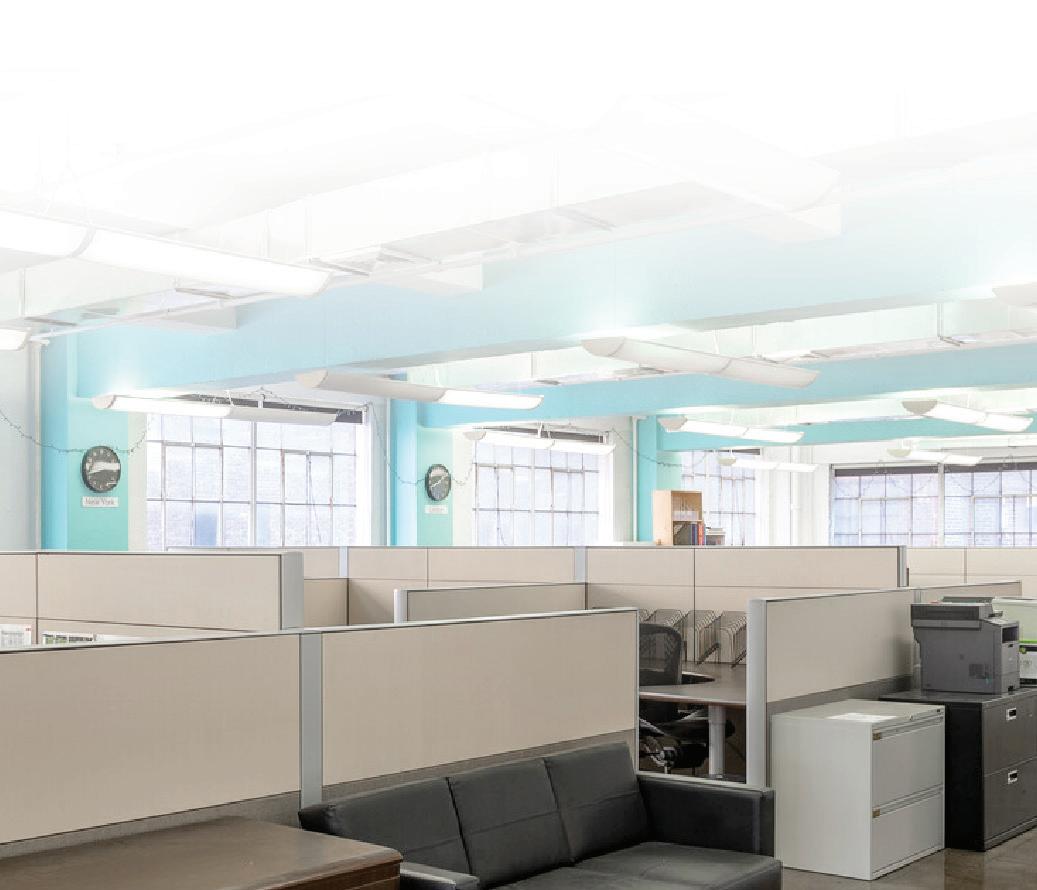


















The multi-phased transformation includes constructing interim housing and a new, 65,000- square-foot CTE classroom building and modernizing eight buildings on campus.
Construction firm C.W. Driver
Companies has broken ground on a $175 million modernization project at Long Beach Unified School District’s (LBUSD) Polytechnic High School in Los Angeles County. The comprehensive project includes building interim student housing and a new, 65,000-square-foot Career and Technical Education (CTE) classroom building and the modernization of eight historic campus buildings. The modernization of Long Beach Polytechnic High School will support success across several study areas while also providing additional space to cater to the needs of all students.
The project will be executed in three strategic phases, with the first focusing on site improvements, utility upgrades and interim housing facilities to prepare the campus for continued operation during construction.
Phases two and three will deliver additional improvements, transitioning campus spaces to serve new academic and student support functions.
A highlight of the modernization is the new, three-story CTE classroom building. The facility will include specialized facilities such as a medical simulation lab supporting the school’s medical pathway, engineering and computer science labs and standard and intensive studies classrooms. Also being built are robotics and automotive technology labs, spaces for the school’s Junior Reserve Officers’ Training Corps (JROTC) and dedicated engineering courtyards and outdoor learning environments.
Interim housing will also be built in a new
complex consisting of 52 portable classrooms, four restroom buildings and a lunch shelter. These temporary facilities will ensure continuity of education during construction.
During the additional phases, scheduled across two subsequent summers, C.W. Driver will modernize the aging infrastructure, update utilities and enhance Long Beach Polytechnic High School’s learning environment through partition walls, new flooring, fire alarms and utility connections across eight buildings. Updates will include comprehensive HVAC and technology modernizations, new audiovisual systems, lighting, electrical and interior/exterior finishes. Additionally, the school will be upgrading its accessibility and safety through ADA-compliant pathways and signage, fire alarm systems and tactile room and exit signage will be updated to meet code.
“This modernization project is more than just the addition of new buildings — it’s an investment in the future of every student at Polytechnic High School,” said Jamie Macartney, project executive, C.W. Driver. “By creating dynamic learning environments tailored to the educational needs of today, we’re helping to equip students with the skills, experiences and inspiration they need to thrive both in school and in life.”
Long Beach Polytechnic High School will also feature several state-of-the-art academic and athletic facilities, along with outdoor collaborative learning areas to further support student engagement and achievement.
The project is scheduled for completion in December 2027.






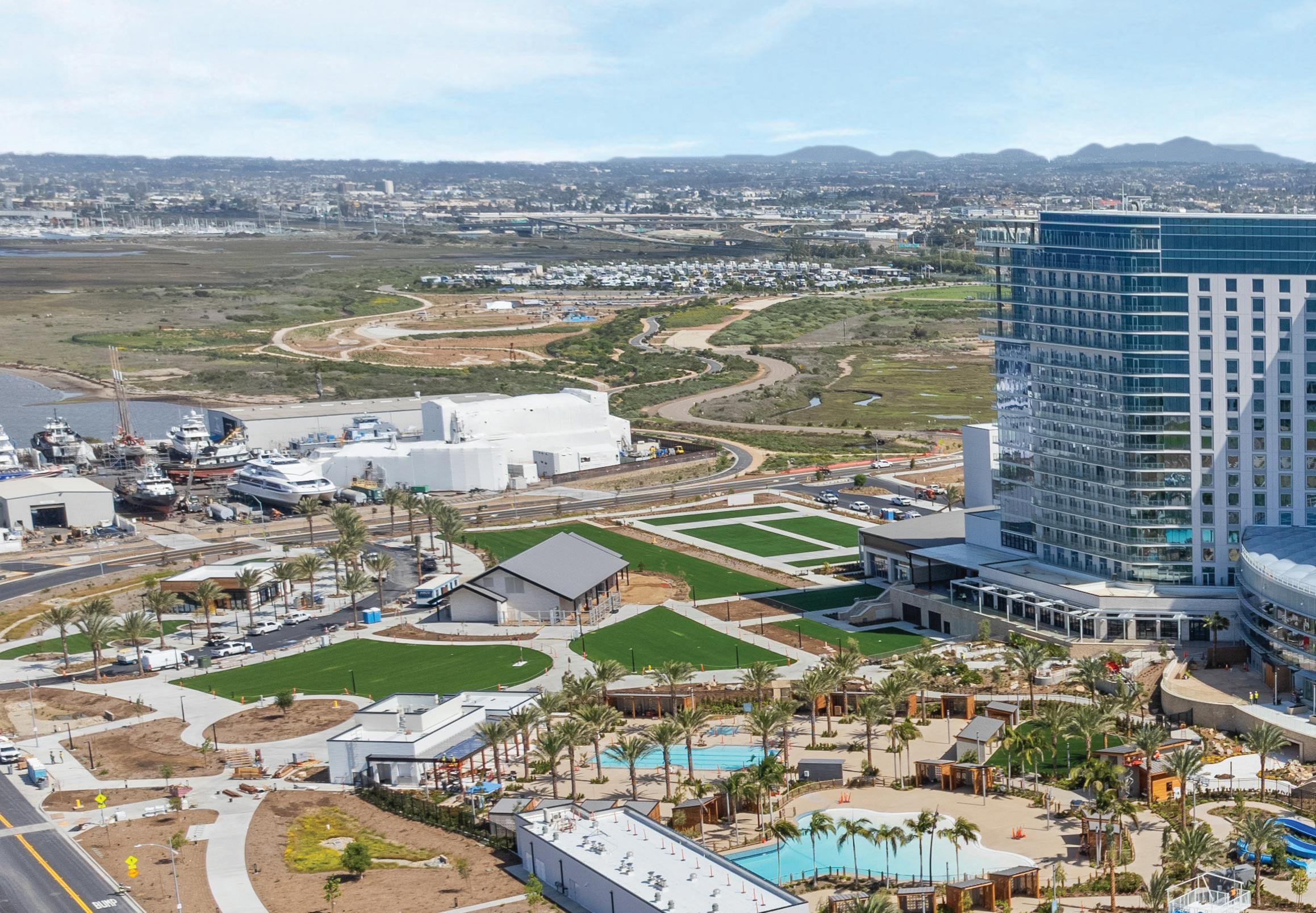
Photos by Captis Lucem Photography
A joint venture of Mortenson Construction (Mortenson) and McCarthy Building Companies (McCarthy) has completed the nearly two million-square-foot Gaylord Pacific Resort and Convention Center project located at the Chula Vista Bayfront in Chula Vista, Calif.
The $1.3 billion, 22-story Marriott resort will have 1,600 rooms, serving as a hospitality landmark for the Southern California region.
The project, located at 1000 H St. in Chula Vista, was a joint venture between Mortenson and McCarthy, along with partners Rida Development, the City of Chula Vista, Port of San Diego, Marriott International and HKS Architecture. It broke ground in August 2022.
A project of this scale required Mortenson/McCarthy to construct a variety of unique and dynamic features to appeal to all visitors. Located seven miles from Downtown

Located seven miles from Downtown San Diego, the resort provides expansive oceanfront and city views alongside a 4.25acre water element, featuring multiple pools, an action-packed waterslide, a lazy river, wave pool, poolside bars, private cabanas and lounging options.
San Diego, the resort provides expansive oceanfront and city views alongside a 4.25-acre water element, featuring multiple pools, an action-packed waterslide, a lazy river, wave pool, poolside bars, private cabanas and lounging options. Additionally, visitors have access to a state-of-the-art, 800,000 square-foot convention center that boasts an enormous open-floor exhibit hall with meeting rooms, elevated ballrooms and areas to host large-scale events. The property also features multiple restaurants, a sports bar, a major atrium and a nine-story parking garage with 1,600 stalls.
The development of Gaylord Pacific Resort & Convention Center required Mortenson/McCarthy to leverage several construction techniques. While creating this project, the partnership implemented an Auger Cast Pile foundation system, using 1,744 piles alongside over 2.5 miles of glass handrail and privacy screens and 110,500 cubic yards of concrete.
Additional early site activities included but were not limited to the rerouting of utilities, demolition and rough grading of the entire site.

“As a joint venture, Mortenson/McCarthy is proud to have completed the Gaylord Pacific Resort and Convention Center in record time in only 34 months,” said Andrew Corson, project executive for Mortenson/McCarthy. “This project will be a beacon for tourism in Chula Vista for decades to come.”
To ensure an on-time delivery, Mortenson/McCarthy developed a proactive project scheduling approach that brought all trade partners together more than six months before work began. This provided ample time to identify time schedules for each of the tasks and for seamless coordination in all parts of the project.
With nearly four million hours logged and over 7,000 craft workers involved, Mortenson|McCarthy earned the Liberty Mutual Workers Compensation Gold Award for exceptional safety measures implemented on the Gaylord Pacific Resort & Convention Center. The award honors teams with a DART rate (days away, restricted or transferred) 80% better than the industry benchmark and at least 200,000 work hours performed on a project.


Extensive years of Industry Experience covering Deposits, Lending and Technology.
At Webster Bank, you’ll find products designed for the property management industry – and a team of professionals with the experience to put them to work for you. Your Webster Bank Relationship Manager and Property Management Team know the challenges you face and give you access to the tools you need to e ectively manage them.
Value, solutions and service – put our resources to work for you.



908.720.4223 rguanlao@websterbank.com

917.231.6758 afusgorniak@websterbank.com

jkowalski@websterbank.com



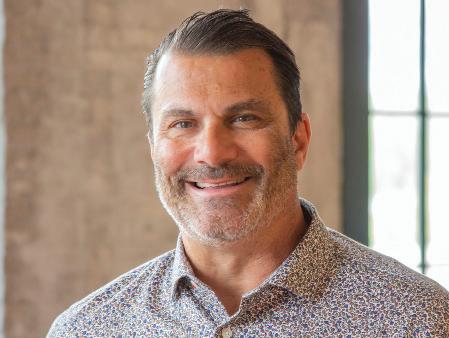
Planning, architecture and interior design firm JCJ Architecture announced a leadership transition at the senior executive levels of the firm. After more than 37 years with JCJ, including over two decades in the role of president, Peter Stevens, LEED AP, has transitioned to principal/president emeritus.
Scott Celella, CSI, CCCA, LEED AP, who has served as the firm’s COO since 2002, will assume the role of president, and Western Region Managing Director Barry Goldstein, AIA, has become COO. James E. LaPosta, Jr., FAIA, LEED AP, will maintain his presence in the role of chief architectural officer, a position he has held since 2002.
Stevens joined JCJ in 1988 as director of business development and assumed the role of president in 2001 as the firm transitioned after 65 years of practice to its third generation of ownership. Under Stevens’ stewardship, Hartford, Conn.based JCJ has grown to include multiple acquisitions, and new locations in New York City, Phoenix, Boston, Tulsa and Las Vegas. He led the firm’s transition from closely held principal ownership to a 100% Employee Stock Ownership Plan (ESOP) structure.
“It has been a tremendous honor to serve as JCJ’s President, to have played a part
in steering a firm so deeply committed to design excellence and client service,” Stevens said. “As I transition to principal/president emeritus, I will continue my involvement in select projects and assist with client relationships, the firm’s M&A activities, ESOP management and community outreach efforts.”
Celella has served as JCJ’s COO for two decades and has been a team member for 30 years, known for his exceptional problem-solving skills, his ability to engage clients and his keen insight into the project design and delivery process.
“This transition marks the fulfillment of a thoughtfully developed succession plan aimed at maintaining continuity and excellence,” Celella said in the announcement. “My focus will be to build upon and strengthen the firm’s foundational principles that have brought us to a position of prominence in our industry and to cultivate the firm’s future leadership. We hope to expand our circle of clients who have come to appreciate the engaged and empathetic design approach that has characterized JCJ for so long.”
Goldstein had been the managing director of JCJ’s Western Region for two years. Previously, Goldstein held key senior-level positions at several architecture firms and spent five years as owner of an Arizona-based design practice.


Real estate finance advisory firm Arrow Real Estate Advisors has expanded its team with the addition of Zachary Strauss and Jonah Schultz as analysts.
“We are thrilled to welcome Zachary and Jonah to the Arrow Real Estate Advisors team,” said Morris Betesh, founder and managing partner. “Their strong analytical skills and passion for commercial real estate will be valuable assets as we continue to expand our capabilities and deliver exceptional service to our clients.”
Strauss is actively involved in the underwriting and execution of debt and equity placements across a diverse range of asset classes, including multifamily, industrial, retail and hospitality properties. Prior to joining Arrow, he gained valuable experience at Kushner Companies, where he supported the acquisitions team, and at Cushman & Wakefield Capital Markets Group,
contributing to high-profile transactions in major markets across the United States.
Schultz is responsible for underwriting, structuring and facilitating commercial real estate debt and equity transactions across a diverse range of asset classes, including multifamily, office, industrial and retail. Before joining Arrow, he worked at Matthews Real Estate Investment Services, creating financial models in support of the brokerage team.
Founded in 2024 by industry veteran Morris Betesh, Arrow Real Estate Advisors is a real estate finance advisory firm that partners with developers. Operating across all asset classes, the firm delivers customized financial solutions, specializing in permanent financing, construction financing, debt structuring and raising joint venture equity.

Design firm Arcadis announced the addition of Pallavi Shrivastava to its New York City office as principal and workplace strategist in the Workplace Architecture Studio. With over 20 years of experience across the U.S., India and Singapore, Shrivastava brings expertise in human-centered design, workplace strategy and business transformation to Arcadis.
“We are excited to welcome Pallavi to the Arcadis team,” said Susan Soehnlen, global practice group director for Workplace Design at Arcadis. “Her experience, vision and passion for sustainable, human-centered workplace design align perfectly with our mission to create spaces that inspire innovation, foster collaboration and drive meaningful change for our clients. Pallavi’s leadership will further enhance our ability to deliver workplace strategies that are not only impactful but also deeply rooted in human and environmental resilience.”
Shrivastava’s global career spans roles as designer,
architect, workplace strategist and business leader, working with Fortune 500 companies delivering transformative workplace solutions that align with business objectives and create lasting impact. She is an internationally recognized expert with numerous publications and a published book to her credit.
Having held leadership positions with global firms such as JLL, Cushman & Wakefield and Space Matrix, Shrivastava is known for her ability to strategically adapt businesses to market demands while driving profitability. Her unique perspective, shaped by living and working across continents, enables her to bridge Eastern and Western paradigms of design and business with remarkable insight and creativity.
She is also deeply engaged in professional organizations such as CoreNet Global, CREW Network, RICS and ULI, where she has served on leadership roles and mentors emerging professionals in the field.


International design firm Ware Malcomb has promoted Damian Melo to regional director and Sean Van to director, regional business operations, based in the firm’s New York City office.
“Damian and Sean have each made key strategic contributions to the growth and success of our New York office,” said Bill Sotomayor, principal at Ware Malcomb. “These well-deserved promotions will further leverage their experience, exemplary leadership and outstanding relationships across our entire Northeast region.”
Melo will continue to guide the growth and vision of the firm’s New York office and support the broader Northeast region. Active in the industry since 1997, Melo joined Ware Malcomb in 2017 as studio manager, bringing deep expertise in both architecture and interior design. He was promoted to director, interior architecture and design in 2023.
A licensed architect in multiple states, with a strategic mindset and commitment to excellence, Melo played a
significant role in the design and build-out of the firm’s relocated New York City office and has established lasting client relationships. He has worked across multiple sectors, including corporate office, financial, retail, nonprofit, landlord services, industrial, warehouse and research and development facilities.
Melo earned a bachelor of architecture degree from the New Jersey Institute of Technology.
Van joined Ware Malcomb in 2021 as a senior project manager supporting the Northeast interior architecture and design team and quickly made an impact through his leadership and operational insight. He was promoted to regional operations manager in 2023 and has worked on a wide variety of project types, including commercial, municipal, national retail, educational, hospitality, residential and branding.
He earned a bachelor of science in architecture from Pratt Institute in Brooklyn, N.Y. and an MBA from Rutgers Business School.
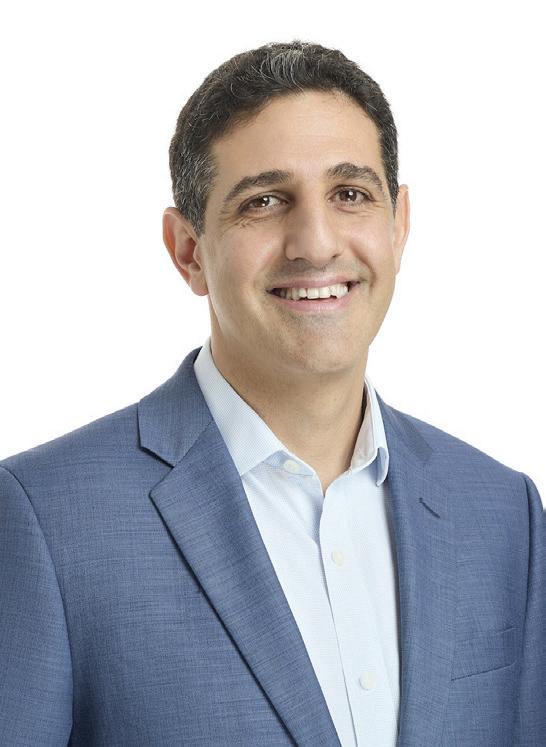
Commodore Construction, a Mount Vernon, N.Y-based national construction company founded in 1995, has appointed industry veteran Doron Netanel as its new chief executive officer.
Netanel will be responsible for overseeing the company’s current operations, strategic growth initiatives and its expanding pipeline of construction projects. He will also lead Commodore’s future development strategies which include restructuring its business lines and augmenting its team of professionals through additional key hires.
“This is an exciting time for both Commodore and our industry, and we are delighted to have Doron onboard as our new CEO,” said Chairman and Cofounder Gerry Boyle. “We believe this is the right time for an organizational ‘reset’ as we focus on expanding while still maintaining the entrepreneurial spirit that has been
our strength since the company first launched. Doron’s international experience and in-depth knowledge of the construction sector, combined with the strong industry relationships he has built, will allow him to hit the ground running in his new role.”
Netanel brings more than two decades of diverse industry experience to his new role at Commodore. He has held various positions throughout his career in construction, real estate development, public-private partnerships and IT at both private and publicly traded companies. He most recently served as CFO with international construction company Electra USA, where he oversaw the financial, compliance, insurance and IT operations.
He holds a bachelor’s degree in economics and accounting, as well as an MBA in finance and financial management from Tel Aviv University.

























We are constantly upgrading our approach and methods to save our clients time and money by delivering the most progressive services and tools in the industry.
Why? To always increase the value of our buildings and enhance the lifestyles for our residents.
Large to small, we tailor all our services to meet the unique needs of each of our clients. A total commitment to quality service is what has made Century one of the most trusted management companies in New York for over 40 years.
Connect with our expert team today to find out how we can help.

With a career rooted in public service, real estate and economic development, Lindsay Greene leads the Brooklyn Navy Yard’s work to create accessible pathways to middle-class jobs, foster urban manufacturing innovation and grow an inclusive economy for New Yorkers.
How long have you been in the industry?
I’ve been in government and public service for 10 years. But if you count my time at Goldman Sachs’ Urban Investment Group (UIG), where I started in 2006, it’s almost 20 years.
What brought you into the business?
Growing up in Washington, D.C. in the ’80s and ’90s, I was always curious about why certain neighborhoods felt safer or had better services than others. I lived in Southeast D.C. for much of my childhood, then later moved to Capitol Hill. I saw firsthand the stark differences in access to grocery stores, restaurants and basic amenities. It wasn’t until I joined UIG that I realized these differences were the result of economic development and urban planning decisions. That’s when it clicked: I could spend my career working to build healthier, more equitable cities.
Who inspires you?
My mother and my grandmother instilled in me the importance of investing in myself and building financial security. Later in my professional life, two deputy mayors had a major impact on me: Alicia Glen, who built and led UIG, but came from affordable housing and brought me into public service, and Phil Thompson, a brilliant urban
planner and policy thinker who expanded my understanding of the interplay of economic power and policy making. They taught me how to take the fundamentals of capitalism and channel them toward achieving policy goals that actually help people. On a more personal level, my wife, who also has a background in policy and government, helps me translate big ideas into action.
What’s the difference between citywide projects and focusing on one?
In a lot of ways, it’s incredibly freeing. In city government, especially at the Economic Development Corporation, we had to think about every industry and the city’s economy as a whole — which could be overwhelming.
At the Brooklyn Navy Yard, it feels like we’re leading a small city within a city. We have a clear and concrete focus: accessible middle-class jobs and urban manufacturing innovation. That focus allows us to dive deeper and build truly unique workforce programs. We wouldn’t be able to do that as effectively if we had to cover every sector of the economy.
What’s the vision for the Yard?
Our vision is to be a hub for inclusive innovation focused on manufacturing and the production of real, tangible goods that improve people’s lives. Like the Yard’s history during the Navy era, we want to lead not only in innovation but also in inclusion — making sure that people who have traditionally been left out of growth industries can access the opportunities we’re creating, not just as workers but also as entrepreneurs and
Lindsay Greene President and CEO
Brooklyn Navy Yard Corporation
business owners.
We’re helping shape the future of industry in a unique urban ecosystem built specifically for that purpose.
How does sustainability play into it?
It’s absolutely fundamental. From an economic perspective, companies have to innovate and evolve to survive. We see our role as helping them do that sustainably, trying to partner with them to find talent as their needs evolve and connect them to experts in manufacturing and supply chain operations, and other business advancement tools.
Environmentally, our campus sits right on a bay and the bottom of a hill, so we’ve developed a comprehensive resiliency plan to protect against flooding and extreme weather conditions. Retrofitting our historic buildings for energy efficiency isn’t just good for the planet —it’s good business sense. Sustainability is woven into every decision we make.
What keeps you up at night?
Making sure that the communities we serve — especially New Yorkers who have historically been left behind — are able to participate in the economy of the future. So many industries, real estate included, still struggle with diversity.
Given that, I worry about whether we’re doing enough to truly connect people to the new industries emerging at the Yard and make sure people know these opportunities are out there and are very real, even if they are daunting.



The financial backing of a global bank, and the streamlined structure and agility of a boutique bank that will keep your business moving forward.
BHI offers full commercial banking services that combine the personal attention of a prestigious boutique bank with the expertise and financial strength of Bank Hapoalim – the leading financial institution in Israel.
With a footprint in the largest U.S. metropolitan areas, we are committed to creating innovative funding solutions for your short– and long-term needs and providing convenient banking and liquidity products for your everyday business needs.
www.bhiusa.com
Simply because of the fact that we all need to live somewhere, multifamily has been one of the most resilient commercial real estate sectors, and 2025 should prove no exception. Rent growth and vacancy remain solid, though slightly below the long-term average as new units are absorbed, observers say. Performance varies in individual markets in this most personal of sectors, but overall 2025 is a good time to be in multifamily, as we can see by the numbers.
23 million

66.4%
The percentage of multifamily assets under construction that are projected to be delivered in 2025. (Avison Young, “Q1 2025 U.S. Multifamily Market Overview”)
The number of apartment units in the United States. (National Multifamily Housing Council) $143 billion
The investment monies attracted to the multifamily sector in 2024, accounting for more than one third of the total commercial market. (Statista)
2.0% to 2.5%
The expected multifamily rent growth in 2025. (Fannie Mae, “Multifamily Economic and Market Commentary,” January 2025)
4.9%
The projected multifamily vacancy rate at the end of 2025. (CBRE, Multifamily, “U.S. Real Estate Market Outlook 2025”)
$370 billion to $380 billion
The projected volume of multifamily originations in 2025. (Freddie Mac, “2025 Multifamily Outlook”)



Zetlin & De Chiara LLP, one of the country’s leading law firms, has built a reputation on counseling clients through complex issues. Whether negotiating a contract, resolving a dispute, or providing guidance to navigate the construction process, Zetlin & De Chiara is recognized as a “go-to firm for construction.”



